Nigerian American rapper WemmyMo hopes to help support his family by making music—and he’s

his crew with
 By MATT HARVEY
By MATT HARVEY
24 CHICAGO’S FREE WEEKLY SINCE 1971 | JANUARY 9, 2020 family A affair
filled
cousins.
CHICAGO READER | JANUARY 9, 2020 | VOLUME 49, NUMBER 14

IN THIS
south and west sides.
09 News A dispatch from a line to
version of Tina Fey’s 2004 film about queen bees lacks sting; Turn Here—Sweet Corn dramatizes Atina Diffley’s memoir about her victory over Koch Industries.
FILM
22 Small Screen The Netflix
CITY LIFE
04 Shop Local Death by Toys provides a trippy trip back in time.
FOOD & DRINK
05 Drinks The five best places to indulge in booze-free concoctions this Dry January

buy weed at a dispensary, where the tote bags are free, the branding is consistent, and security wears Blue Lives Matter hats.
ARTS & CULTURE
13 Museum The Balzekas Museum of Lithuanian Culture provides a piece of home to Lithuanian immigrants.
14 Obituary Charlie Vernon, a “droll dance warrior,” dies at 66.
15 Community A16-year-old south side native is creating an artistic safe space for youth to express their voices.
THEATER
NEWS & POLITICS
06 Joravsky | Politics How to talk to children about legal weed, Donald Trump, and endless Middle Eastern wars
08 Isaacs | Culture The Arts and Business Council heads to the
16 Preview Nestor Gomez turns the “stupid stuff ” into storytelling gold; Pegasus Theatre Chicago helps young writers take flight; and spinning empowerment into gold with Feminist Fairy Tales.
20 Review The touring musical
children’s special John Mulaney & the Sack Lunch Bunch is basically a fertility drug.

23 Movies of note Just Mercy uses elegant close-ups to center people over politics, putting a literal face to the injustice at hand; Botero beautifully tells the story of the intensely private Colombian painter and sculptor.
MUSIC & NIGHTLIFE
24 Feature Nigerian American rapper WemmyMo hopes to help support his family by making music—and he’s filled his crew with cousins.
28 Shows of note Yola, Chandeliers, Sons of the Silent Age,
more this week
The Secret History of Chicago Music Blues singer Lucille Spann earned a share of her famous husband’s spotlight.
Resolution Leor Galil plans on checking out every CPL branch this year.
Early Warnings Girl K, Kesha, Kneebody, and more justannounced concerts
Gossip Wolf Noname’s Book Club pushes library cards on National Fuck Amazon Day, Led Zeppelin 2 tour to celebrate Led Zeppelin III, and more.
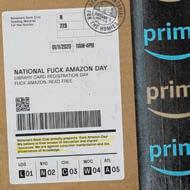
TO CONTACT ANY READER EMPLOYEE, E-MAIL: (FIRST INITIAL)(LAST NAME) @CHICAGOREADER.COM
PUBLISHER TRACY BAIM EDITORS IN CHIEF SUJAY KUMAR, KAREN HAWKINS CREATIVE LEAD RACHEL HAWLEY MUSIC EDITOR PHILIP MONTORO THEATER AND DANCE EDITOR KERRY REID CULTURE EDITOR BRIANNA WELLEN
ASSOCIATE EDITOR JAMIE LUDWIG
SENIOR WRITERS MAYA DUKMASOVA, LEOR GALIL, DEANNA ISAACS, BEN JORAVSKY, MIKE SULA
EDITORIAL ASSOCIATE S. NICOLE LANE
LISTINGS COORDINATOR SALEM COLLO-JULIN CONTRIBUTORS ED BLAIR, NOAH BERLATSKY, LUCA CIMARUSTI, MARISSA DE LA CERDA, MARI COHEN, JOSH FLANDERS, SHERI FLANDERS, JACK HELBIG, IRENE HSAIO, CATALINA MARIA JOHNSON, MONICA KENDRICK, STEVE KRAKOW, NOËLLE D. LILLEY, JAMIE LUDWIG, MAX MALLER, ADAM MULLINS-KHATIB, J.R. NELSON, JEFF NICHOLS, MARISSA OBERLANDER, MATTHEW SIGUR, CATEY SULLIVAN
DIRECTOR OF DIGITAL JOHN DUNLEVY
DIRECTOR OF PUBLIC ENGAGEMENT & PROGRAMS KRISTEN KAZA
SOCIAL MEDIA COORDINATOR JANAYA GREENE MEDIA PARTNERSHIPS COORDINATOR YAZMIN DOMINGUEZ
ADMINISTRATIVE ASSISTANT TARYN ALLEN
ADVERTISING
312-392-2970, DISPLAY-ADS@CHICAGOREADER.COM CLASSIFIEDS: TALLEN@CHICAGOREADERCORP.COM
OPINION
Love Dan Savage busts
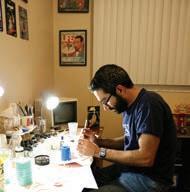
myth of modern porn and offers advice on NSFW pics of exes.
SALES DIRECTOR PATTI FLYNN
VICE PRESIDENT OF SALES AMY MATHENY CLIENT RELATIONSHIP MANAGER TED PIEKARZ SENIOR ACCOUNT REPRESENTATIVES LENI MANAA-HOPPENWORTH, LISA SOLOMON CLASSIFIED SALES MANAGER WILL ROGERS
NATIONAL ADVERTISING VOICE MEDIA GROUP 1-888-278-9866
VMGADVERTISING.COM
JOE LARKIN AND SUE BELAIR
DISTRIBUTION CONCERNS distributionissues@chicagoreader.com 312-392-2970

STM READER, LLC
BOARD PRESIDENT DOROTHY R. LEAVELL
REPORTER’S NOTE
DRUG DEALING DOESN’T exactly lend itself to close-up media coverage. But on the eve of Illinois’s recreational cannabis legalization I decided to try convincing a weed delivery guy to show me his world. I had little to o er him as an incentive—for obvious reasons the story had to preserve his and his clients’ anonymity and couldn’t serve as an advertisement for his business—beyond a philosophical argument. Luckily, Weedman is a philosophical guy. As an herb evangelist he took to the idea of a story that would serve
to normalize and demystify weed procurement and consumption. He was taking a risk peeking out of the shadows but he seemed to think it was worth it to counter o cials’ narratives about people like him. Weedman’s world is underground but in plain sight, populated by ordinary people, our neighbors and friends. The most intriguing thing about it turned out to be Weedman himself. — MAYA DUKMASOVA ON HER DECEMBER 26 COVER STORY “WEEDMAN’S NOT WORRIED”
TREASURER EILEEN RHODES SECRETARY JESSICA STITES AT-LARGE SLADJANA VUCKOVIC
CONSULTANT CAROL E. BELL
READER (ISSN 1096-6919) IS PUBLISHED WEEKLY BY STM READER, LLC 2930 S. MICHIGAN, SUITE 102 CHICAGO, IL 60616 312-392-2934, CHICAGOREADER.COM
COPYRIGHT © 2019 CHICAGO READER PERIODICAL POSTAGE PAID AT CHICAGO, IL
ALL RIGHTS RESERVED. CHICAGO READER, READER, AND REVERSED R: REGISTERED TRADEMARKS ®
ON THE COVER: PHOTO BY NOLIS ANDERSON. FOR MORE OF ANDERSON’S WORK, GO TO NOLISANDERSON.COM.
2 CHICAGO READER - JANUARY 9, 2020 ll
and
32
34
35
35
36 Savage
a
CLASSIFIEDS 38 Jobs 38 Apartments & Spaces 38 Marketplace
THIS WEEK
ISSUE
The Chicago Reader is community-centered and community-supported.




CHICAGO FOR CHICAGOANS
You are at the heart of this newspaper. Founded in 1971, we have always been free, and have always centered Chicago. Help us to continue to curate coverage of the diverse and creative communities of this fabulous city.




Your donation keeps the presses rolling.
IN HERE: www.chicagoreader.com/members
JANUARY 9, 2020 - CHICAGO READER 3
CHIP
WANT TO DONATE VIA CHECK? Make checks payable to “Chicago Reader” and mail to Chicago Reader, Suite 102, 2930 S. Michigan Avenue, Chicago, IL 60616. Include your mailing address, phone, and email—and please indicate if you are okay with us thanking you by name in the paper.
shop local
A trippy trip back in time
Death by Toys specializes in repurposed action figures, 80s nostalgia, and a bestselling empty box you have to see to believe.
By MOLLY HARRIS
DEATH BY TOYS deathbytoys.storenvy.com
Death by Toys is a microcosm of 80s weirdness. Dan Polydoris, the Chicago-based online shop’s founder and supreme leader, is a collector with a capital “C.”
As he explains it, his passion for toy collecting started early: during his childhood in the 80s, when Steven Spielberg had an iron grip on pop culture and Saturday morning cartoons had a godlike status among the youth of America.

“It was a time when the show and the toys had a relationship that they don’t really have anymore,” Polydoris says. “Back in the 80s, it was such a formula of ‘make a TV show and make the action figures to go with it.’”
The dichotomy placed toys and television shows on equal footing. “It was backwards,” he says. “Rather than making action figures to promote the show, it was like, ‘let’s
make these toys [like He-Man ] and make a TV show to promote the action figures.’”
Death by Toys began in 2010 as ChicagoToyCollector.com, where Polydoris catalogued his love of 80s merchandising and nostalgia. While waiting for the birth of his son (and in lieu of a project to pass the time) he repainted Star Wars characters to look like Nintendo figures.
“I used junkers,” he assures me. I nod, assuming this is a Star Wars character. It turns out junkers are cheap versions of popular action figures, and an Internet search verifies Polydoris’s estimate that there are millions of them floating around eBay and at flea markets. Polydoris posted the recast Star Wars/Nintendo figures to Chicago Toy Collector for fun, and a story about them was soon picked up by the video game website Kotaku. Almost immediately, he started getting requests to purchase the figures, and a company was born.
“The first time I got real weird with stuff was when I took some cotton balls and made The Fog as an action figure.” Polydoris was expecting pushback from customers unwilling to spend $35 on cotton in a plastic shell, but the figures sold out in minutes.
In 2015, he renamed the site Death by Toys, and the creations grew even more abstract.
“I went from painting intricate tributes, to putting garbage inside of other garbage and then gluing that to another piece of rectangular garbage.” He pauses. “People were cool with it, though, horror fans in particular. They just get [it].”
As Polydoris is walking me through his workroom, we come upon a small tube TV. He tells me he bought it at a sample sale for $1. It is a marvel of 80s engineering, in that it is a giant square and must weigh at least 94 pounds. It looks decorative, a relic from a di erent time that seems incapable of being able to function in this day and age; like if a dinosaur suddenly appeared at a job interview with the ability to type 85 words per minute.
Polydoris assures me that it works, and he regularly watches it while he is working.
“A lot of comfort movies,” he says. “A lot of 80s horror.” For him, it appears the comfort movies are 80s horror.

His current work is a mix between elaborate pieces and absurdist comedy. He’s started working more in tropes, as he describes it. A collection so popular he can’t keep it in stock is Deadbeat Dads. If you peruse the
package for Deadbeat Dad, it is nothing. Actual nothing. The Deadbeat Dad has gone out for cigarettes and is not in the box.
It is one of his best sellers.
Polydoris has also moved from creating products about pop culture to creating products for pop culture. He has developed custom toys for the 1997 direct-to-video short horror film Coven , the Seth Meyers Netflix special Lobby Baby, Bleecker Street’s The Art of Self Defense, and artist Jan Hakon Erichsen (who you have probably seen on Instagram popping balloons with knife contraptions that would put Rube Goldberg to shame).
The company is growing. Type “death by . . .” into Google and “Death by Toys” appears second, preceded only by “death by a thousand cuts.” On the Death by Toys site, page after page shows Jehovah’s Witness Playsets, Thanksgiving Blankets, an Action Figure Body Bag, and a Vintage-Style Bu Luke Skywalker, ranging in price from $30 to $120 . . . all sold out.
“I think people love them because it speaks to a stereotype that people get.” v
4 CHICAGO READER - JANUARY 9, 2020 ll CITY LIFE
Dan Polydoris MOLLY HARRIS
Find hundreds of Readerrecommended restaurants, exclusive video features, and sign up for weekly news at chicagoreader.com/ food.
Skip the hangover with Dry January
The five best places to indulge in booze-free concoctions in Chicago
 By MICCO CAPORALE
By MICCO CAPORALE
Come January 1, it doesn’t matter how much any of us have had to drink— we’re all suffering from a holiday hangover. No wonder Dry January, a monthlong commitment to booze-free living, is on the
rise.
Dry January kicked off in 2013 with a British organization called Alcohol Change. Their goal was to inspire people to examine their relationships with alcohol by taking
a month off of drinking. Every year, more people have taken on the resolution, and it’s easy to understand why. Past participants have touted numerous personal benefits: better sleep, weight loss, money saved, de-

creased anxiety, increased energy! One of the lesser discussed outcomes is how working through one’s own triumphs and pitfalls with alcohol can translate to supporting nondrinkers year round.
It’s pretty obvious when someone’s an old hardcore fogy who’s nailed to the “x.” (“Straight edge for life !”) Not everyone with a temporary or long-term commitment to sobriety is going to tattoo an “x” on their hand—and honestly, it’s no one’s business why someone’s not drinking. Less obvious are recovering alcoholics, individuals wrestling with gray area drinking, people in the early stages of pregnancy or trying to conceive, even folks on certain medications, or that night’s designated drivers. In general, alcohol consumption is on the decline nationally. And according to a 2017 study, counties that legalized marijuana (recreationally or medicinally) saw a 12 percent decrease in alcohol sales. All this to say, a lot of Chicagoans will likely be drinking less this year, and not just in January. They need to feel included.
So to stay dry, encourage someone else who’s off the sauce, or avoid accidentally outing a person who isn’t imbibing and doesn’t want to talk about it, have a plan when bar hopping. A sparkling water with lime will always be an option, but for those looking for the ritual and flourish of a mixed drink, nothing beats a mocktail. Here are some great places to enjoy common alcohol-focused outings without the libations.
Beatnik Chicago
1604 W. Chicago Ave. J
JANUARY 9, 2020 - CHICAGO READER 5 FOOD & DRINK
LEMONFILMBLOG
DRINKS
FOOD
continued from 5
312-929-4945 beatnikchicago.com
You won’t miss mimosas or Bloody Marys when you brunch at Beatnik. This hip West Town restaurant serves a heavy dose of Instagram-friendly boho chic with no side of pretentiousness. On offer are three “no proof” cocktails: Half Moon Beach, a blend of club soda, black currant soda, and fresh ginger and lemon; Coldcoction, which expertly tops a mix of cold brew and coffee demerara with vegan whipped cream; and El Niño, a perfect marriage of savory and sweet with lime and grapefruit juice, a pepper-and-mint infused agave, and a dash of Tajín.
No Bones Beach Club 1943 W. North Ave. nobonesbeachclub.com
Come for the tropical-inspired mocktails, stay for the vegan noshes. Wicker Park’s No Bones pairs a robust menu of plant-based options with a breezy, beachside vibe. Each drink is outfitted in an eye-popping assortment of trimmings: fresh flowers, thick fruit wedges, Technicolor umbrellas, and salt rims echoing ocean sands (but much tastier). Choose from four booze-free options: Coco-Chill, featuring pineapple, coconut, orange, and nutmeg; the virgin coconut mojito made with fresh coconut milk; Thai iced tea; and Turmeric of Paradise, a fusion of fresh pineapple and turmeric.
Young American 2545 N. Kedzie Ave. 773-687-8385 youngamericanbar.com
Logan Square has no shortage of bars with zero-alcohol options, but Young American sticks out for a few reasons: it’s extremely accessible from public transit, the atmosphere is cool but comfortable, the music is great, and you can add CBD to any mocktail. It’s a perfect option for just hanging out. Admittedly, their “spirit-free” drinks aren’t as visually inspiring as most, but the unique flavors more than make up for it. Right now, they have three options: a combination of melon, ginger, and lime flavors with sparked cinnamon and rooibos and tangerine tea; golden oat milk paired with strawberry, lemon, and mint; and lemon tonic mixed
with orange blossom water and pineapple shrub. Trust me, you have not tasted anything like these.
Cindy’s 12 S. Michigan Ave. 312-792-3502 cindysrooftop.com
If you’re looking for an after-work refreshment in the Loop, Cindy’s makes nondrinkers nearly undetectable. This large rooftop bar sits at the top of the Chicago Athletic Association hotel and offers a lot of room for mingling. It feels professional without being stuffy and boasts an award-winning sit-down menu for those looking to linger longer. There are three mocktails: Lads and Lassies, which mixes Seedlip Spice 94 with mango, lime, and lapsang souchong tea; CB and T, a blend of Fever-Tree tonic water, Kyoto Black cold brew, and cane sugar; and Effective Immediately, which includes Fever-Tree ginger beer, soda water, and Sweet Peach Noir tea mixed with pineapple, lemon, and herbs de provence.
Virtue Restaurant and Bar 1462 E. 53rd St.
773-947-8831
virtuerestaurant.com
Just a stone’s throw from the University of Chicago is this upscale southern dining spot. Not only is it a great place for a special night out, but Virtue has some of the most affordable mocktails in the city. Most places charge $7-$10 for mocktails—no doubt for the lengthy lists of ingredients and low-shelf-life garnishes—but at $5 a drink, Virtue delivers all the taste and imagination you’d hope for at a more reasonable price. The Hummingbird introduces basil to bitter lemon, but Virtue’s pièce de résistance is the Duke of Earl: Earl Grey Tea, star anise, lemon, and frothy egg white elegantly served up in a champagne glass. v
@miccoslays
NEWS & POLITICS
POLITICS
Explaining the inexplicable
 By BEN JORAVSKY
By BEN JORAVSKY
Amid the joy and jubilation of day one of legal reefer in Illinois came this cautionary page-one Tribune headline posing the question: “Is ‘Just say no’ now a no-go? How to talk to kids about pot.”
Oh, brother. OK—a few thoughts right o the bat.
Number one, in all due respect to the many excellent and hardworking journalists at the Tribune, I’m not sure I’d turn to the Trib anytime soon for child-rearing advice.
I mean, this is the same newspaper that thought it would be a good idea to help usher in the age of Trump by endorsing Gary Johnson,
the Libertarian candidate, for president back in 2016.
And number two—c’mon, Trib. This headline reads like a last gasp of reefer madness—as though marijuana is some foreign substance that kids know nothing about. As opposed to the substance they were smoking in the backyard just last week.
OK, yes, it’s good to talk to your kids about all the world’s tempting vices—gambling and drinking included. But let’s not pretend that Just Say No was anything more than a marketing campaign devised by slicksters who were probably high at the time.
Having said that, I think the Trib is onto
6 CHICAGO READER - JANUARY 9, 2020 ll
& DRINK
pleaserecycle thispaper
How to talk to kids about weed, Trump, and endless Middle Eastern wars
Don’t cry, kiddo! Uncle Ben’s here to explain everything. ARWAN SUTANTO / UNSPLASH
something. It might not be such a bad idea to dedicate at least one article a day to explaining the inexplicable to youngsters.
Like, for instance, one of my personal favorites . . .
Why is it that when it comes to stu like doling out billions to Amazon Chicago is flush with cash, but when it comes to hiring nurses for low-income kids in south- or west-side neighborhood schools, we’re dead broke?
Or, in the realm of marijuana . . .
If marijuana is so bad for you, how come mainly Black people got busted for possessing it?
And if everyone is so happy that it’s legal, why did it take so long to legalize it in the first place?
If you recall, it was a little over a year ago that Governor Bruce Rauner was promising downstate voters he would never allow city slickers up in Chicago to legalize weed.
Like downstaters don’t smoke reefer.
And it was only about five years ago that Mayor Rahm—gearing up for a run for his second term—vowed to fight against legalization. Just like Rahm—leading from behind.
In fact, it was only about seven years ago that the aforementioned Tribune writers declared we should give “a dose of tough love” to young reefer smokers by hauling them o to jail.
Even though it was pretty clear that the only youngsters getting hauled o to jail were Black ones. I still feel bad for all those white teenagers in the suburbs who missed out on the tough love.
Coincidentally, legalization occurred the same week that President Trump led us a little closer to war with Iran by ordering the killing of General Qasem Soleimani.
Within days, Iran’s leaders were vowing revenge. Trump—who had promised to keep us out of endless wars—had dispatched another 3,500 troops to various Middle Eastern hot spots. And congressional Republicans—surprise, surprise—started calling on Democrats to drop impeachment because we have to rally around our president during wartime.
I still remember the protests that erupted over President George W. Bush’s decision to invade Iraq back in March of 2003. Pretty much everything those protesters warned us about has turned out to be true, particularly the prediction that having gone into Iraq, it would be very hard to get out.
At one point, hundreds of protesters marched onto Lake Shore Drive, shutting down rush-
hour tra c.
When the marchers emerged from the Drive on the Gold Coast, the police rounded them up and carted them o to jail.
It was then-Mayor Daley’s way of letting everyone know how much he supported the war and how much he disdained those protesters who dared to close his Drive.
President Bush was forever grateful. In 2006, Bush flew to Chicago to celebrate his 60th birthday with Daley. They dined at a restaurant in the South Loop.
At that time, federal prosecutors were putting together corruption cases against the Daley administration, zeroing in on some of the mayor’s closest City Hall aides.
I know I can’t be the only Chicagoan who suspects Bush’s birthday visit was a not-so-subtle way of telling prosecutors to back o of Daley.
In the end, Bush got his war. Daley got to run Chicago. And a bunch of nettlesome lefties got tossed into jail. Thus giving bipartisanship a real bad name.

By the way, no one from the Bush administration—not Bush, not Vice President Dick Cheney, not Secretary of State Donald Rumsfeld, etc.— ever got prosecuted or impeached for lying or making up evidence to gin up support for that war.
So, here’s another paradox to discuss with the kiddies . . .
How come the people who were right about the war got thrown into jail for speaking out, while the leaders who deceived us into fighting it went unpunished?
Well, I don’t want to start the new year feeling all hopeless. So, consider this . . .

Five years after Bush launched that invasion, the country got all fired up and elected Obama, who had been against the war.
Of course, much of the country promptly went back to sleep once Obama was elected. As the Republicans regrouped and—here we are, in the age of Trump.
As we slip closer to the November presidential showdown, I think it might be a good idea to try that waking up thing again.
I love marijuana legalization as much as the next guy—but maybe we need less reefer and more resistance in the coming months.
Unless, of course, the former inspires you to do the latter. In which case, fire up the bong: we’ve got work to do. v

JANUARY 9, 2020 - CHICAGO READER 7 NEWS & POLITICS
@joravben Saturday, January 18 11:00 am Grant Park •2020 Census •Climate Change •Gun Violence Prevention •Women’s Health Rights and Access •Get Out The Vote issue areas5 www.womensmarchchicago.org outreach@womensmarchchicago.org
Build it and they will come
Arts and Business Council heads to the south and west sides.
By DEANNA ISAACS
Many years ago, I sat in on a half-day seminar on how to read and make sense of the financial reports issued by nonprofit organizations.
It was conducted by an accountant and, to the best of my memory, sponsored by the Arts and Business Council of Chicago. I’ve put what I learned in that seminar to use so many times since, I consider it the most valuable half-day of my work life. Like ninth grade typing class and driver’s ed, it turned out to be genuinely useful training.
So I’m coming to news about changes at the
Arts and Business Council as a fan. Founded in 1985 as Business Volunteers for the Arts (the name changed in 1994), A&BC is a subsidiary of Americans for the Arts, with its own nonprofit tax status and a mission to bring business know-how to the cultural sector. For nearly 35 years, it has recruited volunteers from the corporate world for pro bono consulting gigs at nonprofit arts organizations. They’ve been in demand to work on marketing, finance, and strategic planning, and it’s not unusual for them to progress to service on an arts organization’s board of directors. A&BC trains for
that too.
But when Kristin Larsen took over as executive director in May of 2017, she found a less vibrant organization than she remembered from a previous stint there, as director of programs, back in 2001. (In the interim, she’d been executive director at two theater companies: Remy Bumppo and Stage 773.) A&BC had been bigger and busier then, she says; now, its sta of four and cohort of about 300 volunteers looked underutilized. When she asked the sta how much more work they could handle, they told her they thought they could triple it.

Part of the problem, she says, was that A&BC hadn’t been putting itself out there. At the medium-size arts organizations that make up the bulk of its clients, young arts administrators come and go quickly, and institutional memory about resources can be lost. At the same time, there’d been a shift in the funding that supports the council. Earned (program) income makes up only about 15 percent of A&BC’s budget; the rest comes from business sponsorships and charitable support, which had become increasingly hard to land.
“In 2019 I wrote over $1 million in proposals, and was unable to raise any new money,” says Larsen. “The economy is strong, endowments and profits are growing, and more money is going into philanthropic funding, but it’s not going to the arts. The large foundations are addressing bigger issues that have long gone unmet, issues like public safety, mental well-being, veterans’ affairs, and the income gap.”
Larsen notes that the arts can address those issues as well. But a series of “Heat Maps” published by the Field Foundation in 2017 and again in 2019 demonstrated race-related local inequities: areas of Chicago that are less than 10 percent white were found to be relative arts deserts (home to just 13 percent of the 387 arts organizations working in CPS), with poverty levels double those of the rest of the city and violent crime a stunning 350 percent higher. According to the maps, from 2015 to 2017, 28 percent of Field Foundation grants went to organizations headquartered in those areas.
This led A&BC to undergo a racial equity audit and take a look at where its own work was being done. “For the five years ending in 2018, we’d reached only 36 of the city’s 77 communities, most of them on the north side,” Larsen says.
By the end of 2019 A&BC had extended its
reach to 59 of the 77 communities, and in December Larsen announced that 2020 will be a year of further change. The audit, she wrote, “granted us the opportunity to rethink business as usual and simultaneously confront the obstacles that lay before us—namely, like our nonprofit partners, questions of sustainability and relevancy. It also allowed us the opportunity to reframe and recenter our work.”
There’s some catchy naming attached to these changes, but basically they amount to giving priority to artists and arts organizations in areas of the city that have been marginalized, primarily through the opening of field o ces (“Annexes”) that will o er free drop-in meetings with A&BC sta one day each month, as well as pro bono sessions by appointment with volunteer consultants and feebased workshops on topics like income generation and audience development. Through a partnership with the Chicago Park District, Annexes will be housed in park district cultural centers and field houses in South Shore Cultural Center, Austin Town Hall, Humboldt Park, Garfield Park, Douglas Park, Piotrowski Park, Marquette Park, Sherman Park, Palmer Park, Calumet Park, and Hamilton Park; dates will be posted on the A&BC website calendar page.
A&BC’s traditional team consulting projects, including pro bono strategic plans, will be limited to no more than 20 annually, and available through a newly competitive process that will favor applicants in underserved communities. Quarterly events where organizations can pitch themselves to potential board members will also move to the west and south sides.
It remains to be seen whether putting themselves in the neighborhoods will bring the artists and arts organizations they hope to help through their door. (Official nonprofit status isn’t necessary, Larsen says.)
But if it works as planned, A&BC stands to reinvigorate itself as it nurtures others. v
An orientation for business people interested in volunteering is scheduled for 10 AM-2 PM Saturday, January 25, at the Back of the Yards Branch of the Chicago Public Library (apply/ register by January 12 at the A&BC website); A&BC sta will hold its first field o ce (Annex) hours from 9:30 AM-5:30 PM Saturday, February 8, in South Lawndale; check the A&BC website, www.artsbiz-chicago.org, for location.
@DeannaIsaacs
8 CHICAGO READER - JANUARY 9, 2020 ll NEWS & POLITICS
Arts and Business Council executive director Kristin Larsen COURTESY KRISTIN LARSEN
ON CULTURE
By MARI COHEN


“Somebody’s got weed on them—I can smell it. It’s giving me hope,” joked a young white woman in a pink sweatshirt and pink hat from her place in the middle of the long, winding line in a nondescript room that served as the waiting space for Sunnyside Dispensary in Lakeview. While I saw precious little actual weed during my trip to the dispensary on Sunday—except for the brief moments when marijuana products passed from employers’ hands into customers’ Sunnyside-branded plastic bags—hope was everywhere. Hope that the line would speed up; that a preferred product wouldn’t run out; that the up to seven-hour wait to shop at the dispensary in one of the first days of legalized recreational marijuana would be worth it.
The room, which the dispensary leased for the first few days of January in order to house soon-to-be shoppers, was located just down Clark from Sunnyside itself, which is within shouting distance from Wrigley Field. The dispensary’s windowless exterior is painted entirely bright orange, the color of Sunnyside’s brand, making it pop against the surrounding Clark Street facades. Around 2:30 PM, two security guards in bright lime green vests had the task of dashing hopes of interested shoppers seeking a short line. (Medical shoppers, however, were allowed to enter immediately.) Every few minutes, a
handful of people walked up or pulled over in cars to ask if the dispensary was open; the guards responded with the address of the waiting room and a warning that the wait would be at least half a day long. That fact was commonly greeted with laughter: “We’ll be back in a couple months,” one middle-aged white man joked before walking away. Meanwhile, a Black woman emerged from the dispensary door clutching her Sunnyside bag, shouting “I feel like a winner!”
For those who opted to begin the long wait down the street, Sunnyside staff seemed determined to mitigate the pain of the line-waiting experience as much as possible. Staff swept through the crowd, offering free snacks, water, lighters, stainless steel water bottles, and Sunnyside-branded tote bags.
I heard rumors that pizza and hot dogs had been served earlier in the day. Pop and dance music blared from a wireless speaker. At one point, a staff member approached one section of the line and offered a free weed grinder to whoever had come from the farthest away; the winning man had driven two hours from the south suburbs. (He declined to give his name, since he’s about to start his tenure as a medical resident and is taking advantage of the period in between drug tests, but told me he had come out because, “You gotta try stuff while it’s hot, while it’s new.”

He and his friend had unsuccessfully tried getting into two dispensaries in previous days before landing in line at Sunnyside.)


























JANUARY 9, 2020 - CHICAGO READER 9 NEWS & POLITICS
NEWS High hopes A dispatch from a seven-hour-long line to buy weed at a dispensary, where the tote bags are free, the branding is consistent, and security wears Blue Lives Matter hats.
MOBILIZE A series of political engagement events by the Chicago Reader New Hampshire Primary Watch Party Tuesday, Feb. 11, 6-8 p.m., Free GMan Tavern, 3740 N. Clark Super Tuesday Watch Party Tuesday, March 3, 6-8 p.m., Free Promontory in Hyde Park, 5311 S Lake Park Ave W. Come join the Chicago Reader for ELECTION NIGHT WATCH PARTIES With hosts Ben Joravsky and Maya Dukmasova Live Stream on the Reader’s facebook page
“It’s as good as a line’s going to get,” said an enthusiastic Airpods-sporting Wicker Park resident named Nick, who had been waiting for two hours by the time we spoke. He was paying for parking while he waited, he said, so he was “stoked” about the free stuff. He planned to buy flower, disposable cartridges and pens, and pre-rolled joints. “It’s pretty sweet to be in a room full of Chicagoans that want to smoke pot and buy pot, and it’s legal and we can all talk about it, so it’s a good time.”
And apparently, that good time had been, so far, mostly unspoiled by drama. Scotty Rose, a security guard with a shaved head and intense manner working for Security Chicago, one of several security firms hired by Sunnyside, said that guards hadn’t yet had to handcuff anyone. “We’re trying to keep that no-cuff number,” he told me. (Security Chicago is owned by the son of
Walsh Security firm owner Thomas Walsh Sr., a CPD officer who once assaulted a Black security guard while off-duty and called him the N-word.) Two days ago, they had had to kick out one person who was talking smack to a high-level Sunnyside employee, but that was the only incident, Rose said. Our chat was interrupted by a customer who wanted to know if the online menu was kept up to date based on changes in inventory. Rose—a military reserves member who told me, “I really enjoy protecting people”—said that yes, it was. “See all the shit that I know that I should not know?” he joked to me after the customer walked away.
Sunnyside is the retail brand of national cannabis-producing company Cresco Labs; outside of the city, it operates dispensaries in two suburbs as well as in Rockford and Champaign, and has two medical-only locations in New York. The brand is officially
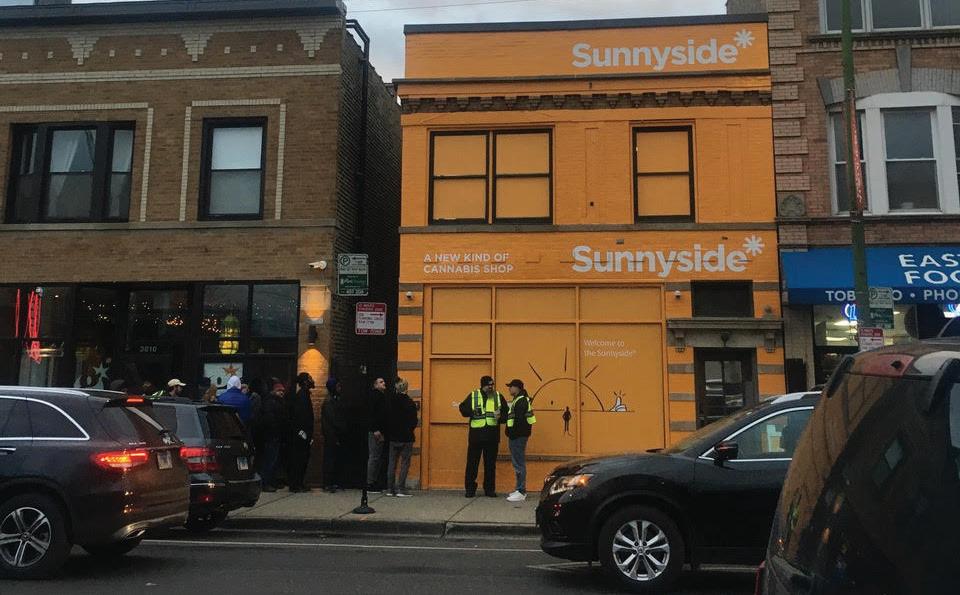
styled Sunnyside*, asterisk included, which looks picturesque on the front of the building but, in paragraphs, makes the name seem to be always carrying some mysterious caveat. The brand has a crisp, start-up like aesthetic—its slogan is “A new kind of cannabis shop.” The signature splashy orange is everywhere, from the walls in the dispensary to the signs in the waiting room reminding people that cannabis is still illegal on a federal level. This kind of branding suggests a tech-savvy efficiency, which was also evident in Sunnyside’s process for shepherding its massive crowds. In the waiting room, shoppers scrolled through the menu on their phones and filled out their orders on paper forms, which were collected by Sunnyside staff and entered into the system. In line, security guards reminded people to have the proper identification ready and cash on hand. When space opened up in the dispen-
sary, guards walked batches of 20 people down the block, where they formed another line right outside the Sunnyside door. Eventually, they were led into an anteroom, where staff checked their documents, and then into the dispensary itself, where they waited in yet another line for the counter.
Online, pictures suggest that Sunnyside’s dispensaries have a sleek and airy Apple-store-like look—stock photos show customers walking around and taking in various displays of cannabis products—but in reality, the Lakeview location is small and functional. If not for the orange walls, signs reminding customers not to smoke and drive, and glass cases in the counter showing off cannabis hard candy—the latter mostly obscured from view by the throngs of customers—you would be forgiven for mistaking the room for a bank or DMV. At the register, Sunnyside staff moved quickly to grab customers’ orders from a locker behind the counter and exchange them for wads of cash. There was room in the process, however, for personalized interaction: I watched a staff member advise a customer on his disposable pen options and the process for applying for a medical license.
Sunnyside’s cheery branding pushes a sense of optimism in the future of Illinois’s recreational cannabis industry. Plenty of optimism is justified: state lawmakers have made racial equity a priority in crafting the recreational marijuana program and have paved the way for expunging thousands of low-level marijuana convictions. The millions of tax dollars collected from eager dispensary users will provide the state with needed revenue (nearly $11 million in just the first few days); some will even fund programs in communities affected in the War of Drugs. On a personal level, some people buying cannabis are hopeful about how it might transform their lives. A woman who gave her name as Sumaya told me that she’s an alcoholic and is hoping that smoking will help her drink less. “Alcohol will kill you,” she said. “It almost killed me in 2018. But marijuana doesn’t kill you.” New friends she’d made in line had helped her fill out her order form for pre-rolled joints with the harlequin strain, known for its high CBD levels that provide anxiety relief without overwhelming intoxication.
And, yet, the asterisk. While the state is
10 CHICAGO READER - JANUARY 9, 2020 ll NEWS & POLITICS
Shoppers wait to enter Sunnyside dispensary as the sun sets in Wrigleyville. MARI COHEN
supposed to be approving more applications from dispensary owners from communities affected by the War on Drugs in the future, the first 11 dispensaries selling recreational cannabis in the city are all white-owned; all but two are on the north side. It’s jarring to see a giant crowd—diverse overall, but still majority white—line up in Lakeview to buy legal weed from a start-up, with the full protection of security firms run by cops, while Chicago police officers are still arresting and charging Black and Brown men for low-level cannabis charges that are now eligible for expungement. CPD has announced its intention to pivot to targeting illegal weed sales, and given their track record, it’s likely that, once again, marijuana use in Black and Brown communities will be disproportionately policed. As if to drive the point home, one of the security guards at Sunnyside’s door wore a Blue Lives Matter symbol on his knit black hat.
One thing that’s clear is that Sunnyside’s “new kind of cannabis shop” is unlikely to completely displace the old. Yes, the dispensary’s success shows that thousands of people in and around Chicago are willing to stand in long lines and pay high taxes in order for a chance to purchase weed legally.
There are certain upsides to using a dispensary: several people I talked to said they liked having confidence in the drug’s quality and safety and they enjoyed the expansive menu. “At home, you just take what you can get. Now I get a choice,” said Karah M., who had driven all the way from Milwaukee to buy edibles and joints.


But that doesn’t mean that dispensary users will be fully giving up their existing methods of buying weed. David, from Rogers Park, said that he had arrived at 9 AM to line up to buy from Sunnyside’s collection of edibles and vapes, but that he wasn’t interested in purchasing their flower. “The prices are kind of outrageous right now,” he said. (Flower sells for $19.56 a gram.) “I’m still gonna stick with my regular guy.” One buyer, almost to Sunnyside’s door at the end of her long wait, echoed the sentiment: “I’ll still be supporting my local Chicago weed seller,” she said with a laugh. Her friend, a UW Madison student, agreed: “I have dabs sitting on my table at home. This is just for the experience.”

JANUARY 9, 2020 - CHICAGO READER 11
v @maricohen95 NEWS & POLITICS “It’s pretty sweet to be in a room full of Chicagoans that want to smoke pot and buy pot, and it’s legal and we can all talk about it, so it’s a good time.” —Nick from Wicker Park 150+ VENDORS 100+ SPEAKERS THE LARGEST CANNABIS INDUSTRY FOCUSED ON ILLINOIS! necann.com/2020-illinois Contact ads@chicagoreader.com or call 312-392-2970 APRIL 3-4, 2020 THE CHICAGO HILTON, IL I C C LLINOIS ANNABIS ONVENTION THE





12 CHICAGO READER - JANUARY 9, 2020 ll GetYourSwag! www.chicagoreader.com/shop
ARTS & CULTURE
A piece of Lithuania in the heart of Chicago
The Balzekas Museum of Lithuanian Culture provides a piece of home to Lithuanian immigrants.
 By SRUTHI DARBHAMULLA
By SRUTHI DARBHAMULLA
Adrab building complex in Chicago’s West Lawn houses the offices of powerful Chicago Democrat Michael J. Madigan, aka the Velvet Hammer, speaker of the Illinois house. His o ce sits on the second floor of the somber edifice at 6500 S. Pulaski , its exteriors brown and gray and respectable.
This is, however, not the only thing at 6500 S. Pulaski. A Lithuanian flag at the door o ers up a tantalizing hint to idle passersby. The Balzekas Museum of Lithuanian Culture, the largest Lithuanian museum outside of Lithuania, is an unlikely neighbor for Madigan’s chambers.
“When you go to another country, you don’t lose your background, you add to the background,” says Stanley Balzekas Jr., a 95-yearold Lithuanian American who founded the

museum 50 years ago.
“In a little way we try to present what Lithuanians are,” he says. “Our role is to show non-Lithuanians something about Lithuania. Our role as a museum is to bring different groups together.”
An eclectic mix of objects populates the museum: amber beadwork, traditional costumes, Easter egg trees, and religious objects—evidence of Lithuania’s strong Catholic tradition—speak to everyday Lithuanian life, while historical maps depicting Lithuanian occupation by the Russian Empire, Nazi Germany, and the Soviet Union point to Lithuania’s turbulent political past. There is a children’s museum, a research center, and a library.
The museum’s top floor hosts an exhibit
titled “No Home to Go to,” chronicling the post-World War II flight of Baltic displaced persons, or DPs, to the U.S. Yellowed immigration documents, photographs of life in new homes, and preprinted letters sent by homesick but illiterate immigrants convey the enormity of their journey.
DP immigration was the second of three waves of immigration from Lithuania to the U.S., and Chicago was popular with the newcomers. “Chicago is considered the biggest Lithuanian city outside Lithuania,” says Giedrius Subačius, professor of Lithuanian Studies at the University of Illinois at Chicago. Even today, 100,000 people of Lithuanian descent call Chicago home.
The majority-Catholic population has established churches around the city, and Subačius knows of at least three traditional Saturday schools where aspects of Lithuanian culture such as singing and dancing are taught. The oldest Lithuanian language newspaper in print is in Chicago—Draugas was first published in 1909. And the Lithuanian World Center in the greater Chicago area, in Lemont, is, as its name might suggest, the biggest Lithuanian center in the world.
Chicago’s Lithuanian ties date back to the industrial revolution. “American businessmen needed the labor, so there were no big obstacles to entry,” Subačius says. Lithuanians worked in the stockyards, steel mills, and coal mines. In fact, it is a Lithuanian immigrant, Jurgis Rudkus, who is the protagonist of The Jungle, Upton Sinclair’s muckraking 1906 novel about
Chicago’s meatpacking industry.
When the DPs found themselves as “people who were part of a nation with no territory,” Chicago was a natural choice.
“America offered them entry,” Subačius says. “It is convenient to come where you know someone. Lithuanians continued to pour in the same place.”
Subačius adds that this was also an intellectual immigration. “Writers, teachers, and artists were afraid of Soviet persecution. Intellectual power was stronger here than in Lithuania.”
This was the reason Roma Bielskus’s parents fled Lithuania. They were teachers who found “they were on the lists to be sent to Siberia,” shares Bielskus. In 1944, they fled to Germany, and in 1949 to the U.S., landing in Waterbury, Connecticut, when Bielskus was six years old.
Now 76, Bielskus has lived in Chicago for 50 years. For three of them, she has occasionally manned the gift-shop-cum-reception-desk at the museum. She says many visitors are thirdor fourth-generation Lithuanian Americans, some of whom also pay a visit to the museum’s genealogy department.
Here they seek out the resident genealogist, Karilė Vaitkutė, 53, who also edits the museum’s quarterly magazine, Lithuanian Museum Review. Vaitkutė is in the business of helping people find their roots.
“They have lost their ties,” she says. “They have no one to talk to . . . their grandparents, great-grandparents are dead. They come here to find relations back home.” v
JANUARY 9, 2020 - CHICAGO READER 13
MUSEUM
Stanley Balzekas Jr., founder and president of the museum, in his office. SRUTHI DARBHAMULLA
Traditional Lithuanian costumes on display at the museum
Charlie Vernon, a ‘droll dance warrior,’ dies at 66
 LAURA MOLZAHN
LAURA MOLZAHN
ancer, choreographer, Reader writer, and real estate salesman Charlie Vernon was all about homes: about creating them, sustaining them, and—when the time came— leaving them. A cofounder of Links Hall in 1978, he’d simply needed a space to create, he told me during a 2009 interview. Cofounders Bob Eisen and Carol Bobrow needed that space too. Though Charlie left Links in 1983, the same year he started selling homes, he remained involved. There were reunions and anniversary celebrations throughout the years, and he was on the Links Hall board when he was diagnosed with Hodgkin’s lymphoma in 2008; he’d had to quit. After that, you’d see him sometimes at the new ground-level Links in a wheelchair or with his head bandaged up. Or without these accoutrements. Always cheerful.
Links was a place, Charlie said, “where you could get lost in a moment of creation. Intimate . . . and yet very removed. Links had a sense of seriousness, of purpose, earnest involvement, a belief that things you did and thought mattered. Movement was metaphor, and we were making statements that needed to be heard. . . . Links was a clubhouse for the marginalized artist, who was forced to admit that during Ronald Reagan’s presidency, there wasn’t much
I didn’t see any of Charlie’s early dances. His choreographic career was short, beginning in 1977 at MoMing with Rat Parade, set to Frank Sinatra songs, and ending in 1983 or 1984 with some unnamed piece. In 2009, he recalled for Slumber Party: it was performed at Links against the second-floor space’s two big windows, which Charlie dressed in curtains and lamps to create a snug, homey set, the el rumbling cozily by only yards away. In 1994 I did see Charlie’s Exit Plans in rehearsal,
made for a Links reunion show with Eisen and Bobrow. He’d written a text for it about home, about safety and self-protection. Charlie danced alone in a porkpie hat: a slight, waggish, comic-pathetic figure. What exit did he have in mind? His departure from Links? Whatever it was, he made leave-taking both sorrowful and light.
The art of dance can vanish so quickly, so easily. Though Charlie started writing reviews for the Reader in 1976, they’re nowhere to be found in the archives.
A couple of Charlie’s other stories are there, however, including “Leaving a Di cult Stage” in 2000, a tender, entertaining, flawlessly detailed reminiscence about the old Dance Center of Columbia College in Uptown, on Sheridan near Lawrence. Charlie interviewed many people when it closed but also recalled his own memories of the place, relishing its idiosyncrasies. A former movie house, it had no backstage, so before a show the performers would tiptoe, often holding hands in the dark, to the stage. “I was always reminded of the buddy system,” Charlie wrote. “They seemed vulnerable, standing at attention, their leotards reflecting a gauzy glow.” He called the old Dance Center
“the place where epiphanies happened, bad or good news was received, kids grew up, and artists were born.”

I think every time I talked to Charlie he mentioned his wife, Marybeth Schroeder, and however long they’d been married at that point.
On December 20, 2019, Charlie left her, his three children, and two granddaughters behind. They were undoubtedly the real home of this caring, stalwart, droll dance warrior.
There will be a celebration of Charlie Vernon’s life Sunday, January 12, at 2 PM at the Levy Senior Center, 30 Dodge, Evanston. v
14 CHICAGO READER - JANUARY 9, 2020 ll
Remembering the dancer, choreographer, cofounder of Links Hall, and former
Links Hall founders Bob Eisen, Carol Bobrow, and Charlie Vernon ca.
1980
CHARLES OSGOOD
COMMUNITY
Kennedy Shanks speaks up
The 16-year-old south side native is creating an artistic safe space for youth to express their voices.
By ARIEL PARRELLA-AURELI
At 16 years old, Kennedy Shanks wears her confidence like a favorite sweater.
She navigates the maroon hallways of Lindblom Math and Science Academy in Englewood with an air of humor and poise, proud to have a reputation of acceptance, mentorship, and friendship within her student community.
“Everyone calls me mom,” Shanks says with a laugh.
The sophomore is known not only for her accepting nature and comfortable leadership style, but for her work in engaging her community through arts and activism to change the portrayal of the south side, particularly among minority youth who feel silenced by adults and society, she says. She founded Minorities, Speak Up! in October 2018, and it became an incorporated business in December 2019. She is on her way to making it a nonprofit, with the help of her parents.
Shanks was inspired to start Minorities, Speak Up! after she was bullied at school. She knew she wasn’t the only one and wanted to share her experiences, find other people also
going through hardship, and create a group to discuss injustices like police brutality, violence toward Black and Brown communities, and unequal treatment of other minority groups like LGBTQ people and immigrants.
“I believe that providing a platform that youth could speak about these situations or how we feel would be beneficial to getting our thoughts out there,” she says.
The first wave of this has been through her podcast, Real Talk With Minorities, Speak Up!, in which Shanks—also a poet who performs under the name Mis.Understood—talks with her friends, peers, and family about issues like mental health, stress, body image, safe spaces for minorities or LGBTQ folks, and sexuality.

The second program was a form of outreach: a Christmas clothing drive. The Warm Clothes For The Less Fortunate Clothing Drive received more than 1,000 donations of coats, clothes, shoes, and toiletries, which Shanks and her family delivered on Christmas Day to more than 100 people experiencing homelessness. A portion of the items were donated to Pacific
Garden Mission, a shelter serving homeless families. She says it was exactly how she envisioned spending her holiday—helping others in need.
The clothing drive and Real Talk are just two ways in which Shanks’s organization is making an impact. She says she has more podcast episodes on the way in the new year, and is in the process of creating a youth poetry team and a community music group. She held auditions for her poetry team, Guilty By Truth, in December and hopes to recruit 15 to 20 middle and high schoolers. Shanks wants to create a community music group called Poets in the Park, structured like an open-mike night for adults and teens from the community to come together to share di erent styles of music, storytelling, and skills to learn from one another.
Shanks’s leadership has become a major part of her identity, and she attributes that to the Schuler Scholar Program. The in-school college prep program provides students and their families with a dedicated support team and resources for free throughout high school and into college. For Shanks, it helped her start Minorities, Speak Up! after being exposed to poetry and comedy shows around the city. It also taught her how to be an e ective leader, balance her schoolwork, and support her art.
In April 2019, Shanks had a mental health experience that led to her missing 45 days of school. During that time, Schuler Program counselors kept her up to speed on her homework, checked in with her every day, and made her feel comfortable to carry on.
“If it wasn’t for Lindblom and the Schuler Program, I don’t know where we would be. And what I mean by that is the support system was unbelievable,” says Mary Shanks, Kennedy’s mother. She and Kennedy’s father, Timothy Shanks, express deep gratitude for the program and the ways in which it’s allowed their daughter to grow and heal—while also helping them learn how to navigate a child’s mental health.
Timothy Shanks saw a noticeable change in his daughter after one summer camp for Schuler Scholars in particular. “Kennedy was always bright and could have a conversation and be articulate, but when she came back, I had to break out the dictionary,” he says with an infectious laugh. “Schuler really showed her to be a leader and from what I’ve seen, it really helped her grow.”
For the 16-year-old, the program is more than a prestigious name and a classroom at the end of the hall. It’s become her second family. Since 2001, the Lake Forest-based Schuler Scholar Program has invested nearly
$100 million in the 1,450 scholars—mostly first-generation students, students of color, and low-income students—and sent them to highly selective colleges and universities. Kari Mueller, the program director at Lindblom, says much of this starts with instilling confidence in students, and then giving them evidence that they can succeed, through extracurricular trips and experiences so they can achieve their future goals.
“I think Kennedy always had the mindset of a leader and of someone successful, someone who believes she can do whatever she puts her mind to,” Mueller says.
Minorities, Speak Up! has shown the founder that youth voices matter and her work is far-reaching. Kennedy Shanks says her friends have taken her lead and started to be more vocal about issues bothering them, whether it’s been through her group or on their own terms. She’s noticed that adults—who she felt weren’t doing enough to listen to youth stories—are now more attentive and influenced by her work, which continues to be elevated using social media, word of mouth, media coverage, and through the Schuler Program.
“Before I felt like the adults are like, ‘Okay, we understand, when you grow up, it’ll be different,’” she says. “But now, to hear the struggles that we’re going through and [that] what they’re doing in the world is a ecting us really reassures youth that our voices are being heard and that people are actually listening to what we have to say.”
She was pleasantly surprised to find out that her podcast is not only being listened to in the U.S. but also in South Africa. And it’s precisely what she wants her work to do: spread to global communities and influence minority groups of all kinds and ages.
But first, Shanks wants to include more youth here at home to bolster the organization’s strength and power. While she’s seen her group inspire friends and peers to join her e orts, she wants more to feel confident to speak up and be part of the cause, especially youth in south-side communities who might feel disenfranchised by political or educational systems and stigmatized by the greater country.
“We don’t all have a bad message,” she says. “We’re all not doing bad things. Actually, [there are] people on the south side that actually want to do big things and have so many dreams, and if we get the right resources, then we can accomplish those things.” v
JANUARY 9, 2020 - CHICAGO READER 15 ARTS & CULTURE
@ArielParrella RACHEL HAWLEY
Gomez turns the ‘stupid

into

gold
By JACK HELBIG

Nestor Gomez, “creator, producer, curator, and host” of the immigrant-focused storytelling series, 80 Minutes Around the World, has always lived and breathed words and storytelling. “When I was a kid [growing up in Guatemala],” Gomez explains, “my father would play these records of poetry read by famous Latin American poets. Sometimes they were short poems by someone like Octavio Paz. Sometimes they were longer poems that told a

16 CHICAGO READER - JANUARY 9, 2020 ll THEATER R READER RECOMMENDED b ALL AGES F
PREVIEW Nestor
stuff’
storytelling
The founder of 80 Minutes Around the World brings immigrant narratives to Fillet of Solo.
Nestor
Gomez COURTESY OF LIFELINE THEATRE 80 MINUTES AROUND THE WORLD 1/ 10 -1/24: Fri 8: 30 PM, Lifeline Theatre, 6912 N. Glenwood, 773 761 4477, lifelinetheatre. com, $10. Presented as part of the 2020 Fillet of Solo Festival, 1/ 10 -1/26. For complete festival schedule, see website. JAN 16 – FEB 16 5535 S ELLIS AVE FREE PARKING GARAGE GROUP & STUDENT DISCOUNTS directed by SEAN GRANEY CourtTheatre.org (773) 753-4472 Production sponsored by KIRKLAND & ELLIS Neil Ross and Lynn Hauser
Kate Fry (Mazza).
MOUSETRAP theAgatha Christie’s
story. And I used to lose my mind listening to them.”
Listening turned into telling and writing, and by the time he was in high school he was writing poetry every night. “And after, not as much as I used to in high school. But I was still writing.” Eventually he filled binders and binders with his words. “Some of the poems were bad. But it was just the fact of writing a poem every day. I didn’t show them to anyone.”
Gomez’s words remained hidden in binders until he found his voice, and was confident to let others hear that voice. Before he could tell his stories, he had to live them.
Born in Guatemala City, his life has been a whirlwind since at least 15, when he and his brothers and sisters moved to Chicago, undocumented and knowing almost no English, learning it on the fly.
“My mother and father came here first,” he says. “They were trying to get money together to buy a house.” But before his parents could get that house in Chicago, they separated and later divorced. Nestor’s mom brought her kids to Chicago anyway.
Nestor went to Roberto Clemente High School, and then got married right after high school. “I got my girlfriend pregnant. I told my mother, ‘She is going to move in with us,’ she went, ‘Uh-uh, she is moving out of her house, she is going to get married.’ She was my first wife. I ended up being married three times.”
Without a college degree, Nestor took whatever job he could. “I used to work at a Taco Bell. I used to work 60, 70 hours a week. I worked my way up to management. I started out on the line making tacos. And I worked my way up to assistant manager and then they found out I don’t have my immigration papers. And I got fired. When I lost my job at Taco Bell I had to keep going. I can’t just go home and cry. I have to go and start from the bottom again.
“There was a time when I was so broke.
Because I was getting divorced for the second time. We had bought a house. This was when the real estate market went boom. I lost quite a lot of money. I lost a lot of money. There was a time when I was half a million dollars in debt. Me and my ex-wife bought a building [in Logan Square]. And we basically lost that. We lost all the money we put into that. It was a good investment. But people were not paying rent, they were behind in rent; we had trouble paying the mortgage. I basically ran away from everything. We had a lot of credit card debt. I said I would take care of that. For the next six years there was like $20 in my savings account for the whole week.”
Through all this, Gomez kept writing. And writing. And getting courage to speak his words. Once he went to the Green Mill Lounge to read at the poetry slam. He even signed up to perform. But at the last minute he backed away because his poems were in Spanish, and all the other competitors did poetry in English.
But Gomez was determined to perform in public. “I used to stutter,” he says. “[Performing] was a thing I did to get rid of my fear of public speaking.”
Gomez discovered The Moth, a storytelling competition similar to the poetry slam. Gomez decided to try his luck telling stories, in English, at The Moth.
“For my birthday [my girlfriend] bought me a ticket for The Moth. And I wrote a story for that. I practiced it at home. I practiced it in front of some friends. I went to the slam. I told my story. And I won.” Gomez pauses, and gives a look suggesting that he still can’t believe it. “I didn’t expect to win,” he confesses. “If you win, they invite you to the grand slam. And I freaked out. I knew how good the others were. I started going to a lot of [storytelling] slams and telling my story. It became a big part of my life.”
Gomez didn’t know he was a storyteller, but he had been preparing to be one his whole life. Gomez has a likable, unpolished, unpretentious teddy-bearlike presence on stage. He just steps out and begins speaking. He doesn’t do anything fancy with his words; he lets what he has to say pull his audience in. He talks about his life, and all he has been through, and we are fascinated.
“I tell stories about crossing the border. I tell stories about growing up in Guatemala. I tell stories about my first day in the United States. My first day of school in the United States. The birth of my daughter. The birth of my son. My first divorce. My second divorce. There are very few things I have not told a story about.” Gomez pauses and laughs, “I have a story about going to the washroom and washing my hands.”
Then he adds: “It is not that I am a great writer, that I come up with great ideas,



it is that I have a lot of stupid stuff in my life. If I hadn’t made all those mistakes, I wouldn’t have that much to write about.” v
Gomez and 80 Minutes Around the World perform three consecutive Fridays as part of this year’s Fillet of Solo Festival, which highlights the work of several storytelling collectives around the city this year. Gomez plans to unveil a new story at each of the performances.
JANUARY 9, 2020 - CHICAGO READER 17
THEATER
6241 N. Broadway 773-942-6522 Mon-Sat 11-7 Sun 12-7 PLEASE CONSIDER HONORING EARTH DAY EVERYDAY Buy reused/recycled furniture, housewares, and clothing as often as possible! The EARTH thanks you!
THEATER
PREVIEW

The Young Playwrights Festival turns 33Pegasus Theatre Chicago helps high school students find their voices.

 By KERRY REID
By KERRY REID
Pegasus Theatre Chicago has weathered some storms over the years. But one thing has remained constant for them nearly since their founding in 1984 as Pegasus Players: their annual celebration of young writers.
Pegasus’s 33rd Young Playwrights Festival features three one-act plays, chosen from over 500 submissions from high school students around the city. The YPF program partners with participating schools to provide professional playwriting instruction in tandem with existing drama programs throughout the year. The selected playwrights participate in immersive revision workshops and they also are invited to participate in the audition and rehearsal process.
The three plays this year differ in tone, with Angelina Davila’s Public and Private and Reba Brennan’s Cobalt both taking a mostly realist approach to family conflict and Henry Williams’s Clause 42 providing an absurdist view of the afterlife. But as Pegasus artistic and executive director Ilesa Duncan notes, the common thread is that these young writers are writing about “a sense of betrayal, either personal or systemic.”
Davila wrote her play, about teen siblings facing parental disapproval and a pregnancy scare, last year while a senior at Taft High School. Dialogue exercises in class helped her figure out how to shape her characters and
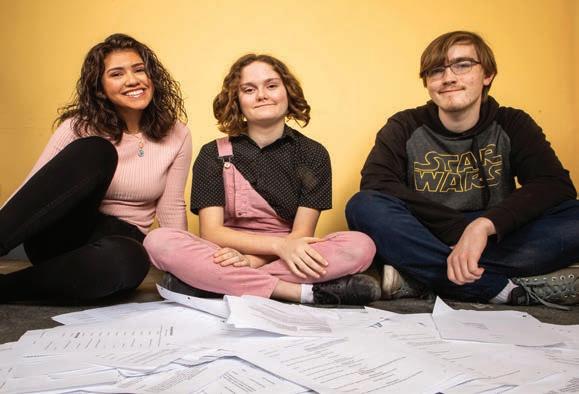
“show it through the words, and not just tell it.” The YPF experience has also made Davila, who always thought of herself as more of an actor than a writer, determined to do both in the future. On the day we talk, she pulls out a notebook she carries with her everywhere. “I write about every time something happens in my life and I think ‘That’s good. I’ll use that.’”
Brennan’s Cobalt , in which a teenage girl runs away to live with a group of similarly displaced youth, began as prose. But she found that theatrical stagecraft enhanced the physical world of the story. “I learned that I loved to include very specific details. I put a lot of details in the lights. I named the play Cobalt because I had a specific lighting e ect in mind.” The title now evokes the twilight world her marginalized teen characters occupy.
Williams cites Neil Gaiman’s American Gods as inspiration, but notes that his critique of religion also comes from “my grandfather, who is a Baptist pastor in Arkansas and has seen some of the harmful effects of religion firsthand.” That blending of personal experience with other cultural markers is something Williams believes holds promise for building younger audiences as well as younger writers. “The best way to appeal to any new generation is to break the mold, use new techniques, try new genres that aren’t seen in theater too often, and take risks in how you tell these stories.” v
18 CHICAGO READER - JANUARY 9, 2020 ll
Left to
right:
Angelina Davila, Reba Brennan, and Henry Williams COURTESY
PEGASUS THEATRE CHICAGO
YOUNG PLAYWRIGHTS FESTIVAL Through 1/25 : Thu-Fri 7: 30 PM, Sat 2 PM, Getz Theater Center, 72 E. 11th, 773 878 8864 , pegasustheatrechicago.org, $ 30, $25 seniors, $18 students.
Spinning empowerment into gold with Feminist Fairy Tales
The New York-based femme comedy troupe makes their Chicago debut at Sketchfest.
By KAYLEN RALPH
Sleeping Beauty becomes an allegory about consent, Peter Pan is recast as a “creepy” Peeping Tom, and Ariel must weigh whether the “vagina-a-bob” that comes attached to her new legs is worth losing her mermaid tail for after all.
Disney princesses become unwittingly woke feminists in Feminist Fairy Tales , an all-female sketch show cowritten by Laura Lane and Ellen Haun. It makes its Chicago premiere on January 17 and 18 with two prime slots at this year’s Chicago Sketch Comedy Festival.
Directed by Chet Siegel and starring Lane, Haun, and Amber Reauchean Williams, Feminist Fairy Tales first premiered as Femme Fairy Tales at the Upright Citizens Brigade

Theatre in New York in March of 2018, where it ran through January 2019. The show also had a short run at UCB in Los Angeles in November of 2018.

Lane and Haun met while enrolled in the same UCB sketch writing class. Lane brought in a few fairy tale sketches, which Haun thought were “very funny,” funny enough to anchor an entire sketch show. She asked Lane if she could help build it out, and—in true feminist fairy tale fashion—a beautiful creative partnership was born.
“I’m not sure I would have gone through doing the show without Ellen,” Lane says. “It’s not fun writing in a void, it’s much more fun collaborating.”
In the midst of the show’s initial UCB run,
Lane approached Haun about turning their successful show into a book, which she’d done before with This is Why You’re Single , a sketch-show-turned-humorous-advice-book.
Haun agreed, and after writing five sample chapters, the collaborators secured a book agent and in June 2018, they signed a book deal with Seal Press. Cinderella & The Glass Ceiling: And Other Feminist Fairy Tales is set for release on March 10.
“The cool thing about turning a sketch show into a book is you’ve already workshopped the material in front of hundreds of people prior to writing the book,” Haun says. “Not everything translates from the stage to the book, but you know whether the jokes work or not.”
Reauchean Williams has been with the sketch show since its UCB premiere. “A lot of the themes we discuss in the sketch show are pretty universal,” Reauchean Williams says. “We’re dealing with issues like female
friendship, female empowerment, consent, beauty standards, the lack of intersectionality in feminism, cultural appropriation, disparity in socioeconomics.”
SketchFest 2020 is the first festival circuit for Feminist Fairy Tales , and all three performers say they’re excited to dip their toes into the Chicago comedy world.
As for whether they are anticipating a different reception at Sketchfest as opposed to how they’ve been received at UCB in New York and Los Angeles, “It depends on what’s going on in the world,” Reauchean Williams says.
“We performed the Sleeping Beauty sketch about consent days after the Kavanaugh hearing, and the temperature of the room was cold at best,” Lane elaborates.
“It depends on what they’ve read in the news.” v
@kaylenralph
JANUARY 9, 2020 - CHICAGO READER 19 PREVIEW
FEMINIST FAIRY TALES Fri 1/ 17-Sat 1/ 18, 9 PM, Stage 773, 1225 W. Belmont, 773 327 5252 , stage773.com, $15 -$16. For complete Chicago Sketch Comedy Festival schedule, see website.
Feminist Fairy Tales
NIC
RAD
THEATER
It’s not easy being Mean Girls
The touring musical version of Tina Fey’s film about queen bees lacks sting.
By KERRY REID
The drama and intrigue of female friendships has filled works from the sublime (Margaret Atwood’s 1988 novel Cat’s Eye ) to the louche (any installment of the Real Housewives franchise). Tina Fey’s 2004 film Mean Girls mined some of the same cutthroat teenage frenemies territory as 1988’s Heathers—though it was directly inspired by Rosalind Wiseman’s 2002 self-help book about surviving high school cliques, Queen Bees and Wannabes

It makes sense that Fey decided to turn her film into a Broadway musical in 2018—after all, Heathers had already made the leap from screen to stage in a 2014 o -Broadway version by Laurence O’Keefe (who also wrote Legally Blonde: The Musical with his wife and Mean Girls lyricist, Nell Benjamin) and Kevin Murphy. But though the touring production now onstage at the Nederlander has many charming and
witty moments that go down easy, it doesn’t make the case for why this show needed musicalization, or why it’s a better option than staying home and watching the film again. (Though admittedly the latter makes one mourn the lost potential of Lindsay Lohan, even if Rachel McAdams has had a deservedly high-profile career since playing Regina George, the queen of the “Plastics” clique who dominate fictional North Shore High School’s social scene.)
The score by Je Richmond (Fey’s husband) is peppy but disposable. The changes Fey made from the screenplay to the musical’s book feel more like arbitrary lateral moves, rather than reinvestigations of some of the more disturbing elements from the movie. The coach who was preying on two teenage girls (both Asian, which feels like the kind of racial blind spot Fey’s been accused of demonstrating in Unbreakable Kimmy Schmidt ) has been excised. But now
we’ve got Jonalyn Saxer’s Karen, the dimmest bulb in the Plastics coterie, reminiscing about sending nude pictures to an adult man when she was 13, and being upset that he shared them online. In a show that already has trouble deciding if it’s going for black comedy, a la Heathers, or if it wants to be a spritely ode to female empowerment through learning cooperation rather than competition, a moment like that, devoid of deeper context, just feels queasy.
The story of Cady Heron (Danielle Wade), the only child of zoologist parents who was raised and homeschooled in Kenya before joining North Shore’s John Hughes-like world, is also in part a faux-scientific disquisition on cliques (as captured in the song “Apex Predator,” about Mariah Rose Faith’s Regina, who “can smell your fear in this biosphere”), crossed with a classic underdog revenge tale. Cady is initially recruited to infiltrate the Plastics by Janis (Mary Kate Morrissey), Regina’s best friend from middle school who was cruelly shunted aside and now, along with “too gay to function” Damian (Eric Huffman, a winning presence throughout, particularly in the tap-dancing number “Stop”), dreams of ways to melt the Plastics empire entirely.
Crucially, the narration that frames the story, voiced in the film by Lohan’s Cady, now comes from Janis and Damian, which serves to distance us from Cady’s own growing awareness
of what her attempts to fit in have cost her personally and socially. And though the “Burn Book” that sets the high school world on fire still has pride of place, the musical updates the toxic gossip for the age of Instagram and other social media, captured, a la Dear Evan Hansen, through projections of posts and comments. (Finn Ross and Adam Young are credited with video design.)
Cady’s parents are also mostly shunted to the side, making us wonder why they’re not noticing the changes in their kid. (In the film, their cluelessness provides an adult counterpart to Cady’s own stranger-in-a-strange-land sense of dislocation.) But Gaelen Gilliland does admirable triple duty as Mrs. Heron, Mrs. George (Amy Poehler’s line from the film, “I’m not like a regular mom, I’m a cool mom!,” shows up here), and the math teacher Ms. Norbury (played by Fey in the film), who sees Cady deliberately dumbing herself down in order to appeal to Aaron (Adante Carter), Regina’s ex. But it’s Janis who points out “she just pretended to be dumb to get a boy to keep talking to her and it worked. Because that shit always works.” It’s a nail-onhead moment, even if it’s pounded down with a sledgehammer.
There are some additions that really do enhance from the original. Saxer’s Karen gets the most succinct insight into how Cady’s scheme backfired (spoiler alert: she starts becoming everything she hates in backbiting Regina), but also served its own purpose. It’s the Rule of Twos, where two seemingly opposite things can both be true—“like how you were spying on us, but also having fun with us.”
Maybe that’s the best way to look at Mean Girls onstage: we’re spying on the lives of teenagers with appropriate concern for how cliques damage them, while also relishing the stereotypes. Casey Nicholaw’s direction and choreography o ers plenty of tongue-in-cheek interludes; for example, a Halloween party features the song “Sexy,” in which every girl’s costume is a lascivious version of everything from corn to cats. The cast is uniformly endearing, and if you already like the film, you’ll probably not be disappointed. But if you’re looking for something that adds additional insight, rather than just a coating of pop music to the pop psychology? Well, like “fetch,” that isn’t going to happen. v
20 CHICAGO READER - JANUARY 9, 2020 ll THEATER REVIEW
R READER RECOMMENDED b ALL AGES FMEAN GIRLS Through 1/26 : Tue 7: 30 PM, Wed 2 and 7: 30 PM, Thu-Fri 7: 30 PM, Sat 2 and 8 PM, Sun 2 PM, James M. Nederlander Theatre, 24 W. Randolph, 800 775 2000, broadwayinchicago.com, $ 30 -$120.
@kerryreid
Mean Girls JOAN MARCUS
Fanfare
By KERRY REID
Atina Diffley grew up on a farm, but dreamed of combining that rural world with a career as a jazz pianist—“a white Thelonious Monk of the fields,” as she self-deprecatingly recalls in her 2012 memoir, Turn Here—Sweet Corn . Instead, she found a different path to composing a life. Diffley’s story, adapted by Jim Stowell in a solo show now in a world premiere with Saltbox Theatre Collective, provides not just a showcase for storytelling virtuoso Megan Wells as Di ey. It’s also precisely what anyone who is thinking of giving up against the powers-that-be in these dark days needs to hear.
(as was the case with the Di eys’ first farm) is one thing. Seeing it carved down the middle by a corporation that paid the largest-ever pollution fine in the history of federal environmental laws? Inconceivable.
Except of course that we’re so used to seeing corporations get their way that we hold our breath for Wells’s Atina as she decides that she and her family won’t be displaced and dislocated again from the land they lovingly nurtured to achieve their “OSP,” or Organic System Plan. We cheer when she finds Paula Maccabee, the one environmental attorney in the Twin Cities who hasn’t already been put on retainer by Koch Industries as a blockading maneuver against lawsuits. And we start to believe, as Di ey does, that winning is possible.

Diffley achieved notoriety when she took on Koch Industries in 2006 over their plans to install a pipeline over her family’s organic farm in Minnesota, known as the Gardens of Eagan. But that battle comes in the second act of this quietly moving story (directed by Scott Jones) of one ordinary woman’s ability to find extraordinary strength in her family, her community, and herself.

From a failed early marriage to the loss of the first farm she and her second husband, Martin, worked on together (a farm that had been in his family for five generations), Stowell’s script and Wells’s performance honor the defeats that tempered Di ey’s resolve to stand up to corporate predation. Losing land to a public school


Di ey’s voice, as translated by Stowell and embodied by Wells, is poetic and spiritual about the power of the land without ever becoming precious. “Farm soil is a wild animal held in captivity,” she observes. And like a wild animal, it can react unpredictably to weather, and be destroyed by the bulldozers of domestication.
Yet Diffley also acknowledges that she and her family are also displacing wilderness, such as the pack of coyotes that used to run through the abandoned old farm they decide to restore after losing their first. Respect for the land and its history runs through her story, which also resonates with wit, warmth, and a quiet steadying belief in the power of resistance. “Terror does not always mean run,” Wells’s Diffley reminds us. “It can mean act.” Going into this watershed year, I can’t imagine better advice,

a more reassuring presence to deliver it than the incandescent Wells. v



JANUARY 9, 2020 - CHICAGO READER 21
or
REVIEW
for the common woman Turn Here—Sweet Corn dramatizes Atina Diffley’s memoir about her victory over Koch Industries.
Turn Here—Sweet Corn COURTESY OF SALTBOX R TURN HERE—SWEET CORN Through 1/26 : Thu-Fri 7: 30 PM, Sat 2 and 7: 30 PM, Sun 2 PM, the Edge Theater OffBroadway, 1133 W. Catalpa, saltboxtheatre.org, $19, $14 students and seniors. JANUARY 14 - 25, 2020 KENNEDY-KING COLLEGE 740 WEST 63 STREET www.collaboraction.org FOR TICKETS & MORE INFORMATION STUDENT, SENIOR & GROUP DISCOUNTS AVAILABLE "This is the most healing form of activism that I have seen in my life." -GQ, The Q Brothers RD
This is basically a fertility drug
By BRIANNA WELLEN

As a woman of a certain age I am increasingly confronted with people wondering when I’m gonna pop out a few little ones. My mom. My mom’s friends. My dad (who is also my mom’s friend). There’s nothing more devastating than the look in their eyes when I say with all the confidence in the world that I do not want kids and I never will. Well, good news, mom and dad. The Netflix special John Mulaney & the Sack Lunch Bunch has changed my mind.
In the opening scene, stand-up and nonparent John Mulaney is surrounded by a diverse group of perfectly normal children on a Sesame Street-esque set. The kids ask the questions we’re all thinking: Is this supposed to be ironic? Or did John Mulaney really just want to make a genuinely fun hour of television for kids? The answer seems to be kinda both. The 70 minutes that follow are filled with a mix of nonsense visual gags, catchy songs relating to very spe-

cific yet relatable childhood experiences, and emotional talking-head interviews with the featured children and special guests revealing their greatest fears.
The special guests are unexpected and delightful: David Byrne joins one of the members of the Sack Lunch Bunch, Lexi, for a song shaming adults for not paying attention to the creative prowess of children. Richard Kind guests on the talk show Girl Talk . Natasha Lyonne walks onto set seemingly just to say something inappropriate. And Jake Gyllenhaal completely loses his mind. I wondered if the child actors—or the kids watching at home for that matter—even know who these celebs are, but the who hardly matters when what they’re bringing is boundless energy, genuine connection with their fellow actors, and a vulnerability about what still scares them.
The bizarre, smart, unhinged comedy in
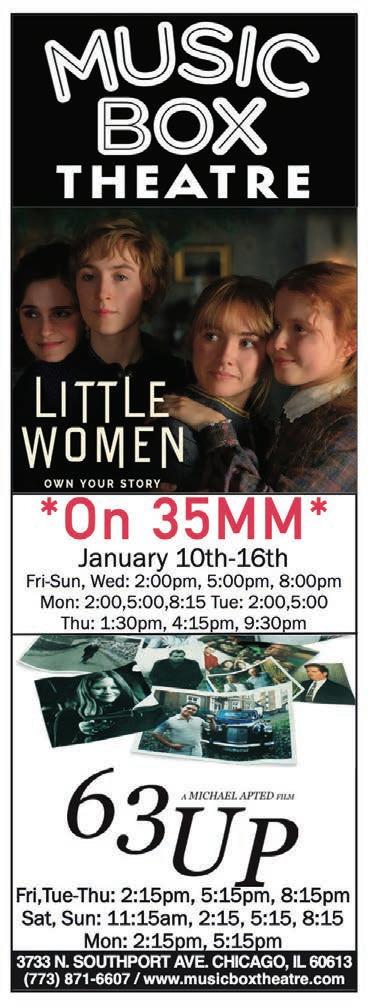
this special excites me not only as a piece of entertainment on its own, but as a source of inspiration for the next generation of comedians. Kids watching will know that comedy doesn’t have to punch down or be shocking or even be “adult.” The best jokes come from not being afraid to share your emotions or experiences, and sharing them in the silliest, strangest ways possible. Watching this special made me feel OK about having kids because it, like so much other content these days, reinforced for the next generation that they can just be themselves with a good spirit and witty mind. Who knew a childless, 30-something white man from Chicago would be one of the most reliable soldiers in the fight against toxic masculinity and a champion for weird and wonderful kids everywhere? v
@BriannaWellen
22 CHICAGO READER - JANUARY 9, 2020 ll FILM
SMALL SCREEN
The
Netflix children’s special John Mulaney & the Sack Lunch Bunch gives hope to the weird wonderful kid in all of us.
ssss EXCELLENT sss GOOD ss AVERAGE s POOR • WORTHLESS
JOHN MULANEY & THE SACK LUNCH BUNCH ssss Streaming on Netflix and appropriate for all ages (really).
NOW PLAYING
R Beauty #2
One of the liveliest and most conceptually interesting of Andy Warhol’s early sound featurettes, this 66-minute movie made from a single camera setup features Edie Sedgwick and Gino Piserchio on a bed, mainly in their underwear, and the voices of Gerard Malanga and Chuck Wein offscreen, Wein supposedly “directing” the film (1965). On the same program, Warhol’s 39-minute Eat (1963), a beautiful silent work that features painter Robert Indiana eating mushrooms meditatively while looking at everything but the camera, and a friendly cat that occasionally joins him in the frame. Despite the evident minimalism of this portrait, the fact that Indiana’s sitting in a swiveling rocking chair introduces a lot of variations in the camera’s relative position—the equivalents, in fact, of pans, tilts, and tracking shots.
—JONATHAN ROSENBAUM Double feature with Lonesome Cowboys. Fri 1/11, 7 PM.
Art Institute of Chicago F
R Botero


Born in Medellín, Colombia, in 1932, painter and sculptor Fernando Botero is arguably the world’s most recognized living artist. Through a series of interviews this documentary beautifully tells the story of an intensely private man whose paintings and sculptures blend his observations of everyday people, his reverence for the art of centuries past, his political leanings, and his sense of humor. Without shying away from the controversy he’s faced, the film details how Botero overcame poverty and adversity, including the death of his son, Pedrito, at age four, to win adoration from the art world and the public alike—though he insists that success or no success, he’d have spent his life painting. Whether you cherish Botero’s work or, like some of his critics, deride his exaggerated, voluminous figures as cartoonish, it’s hard to not find inspiration in his indefatigable passion and work ethic, commitment to his family and home country, and love of humanity.


—JAMIE LUDWIG 84 min. Gene Siskel Film Center

R Howl’s Moving Castle
Japanese animator Hayao Miyazaki follows up
his international hit Spirited Away with this 2004 adaptation of a British novel by Diana Wynne Jones. I haven’t read the book, but the movie’s dreamlike spaces and characters are sometimes worthy of Lewis Carroll. One thing that makes this highly cinematic is the radical fluidity of both age and character: people and objects are constantly transforming, and wisdom doesn’t so much succeed callowness as peacefully coexist with it.
The heroine, a teenage hatmaker, runs afoul of a wicked witch and gets turned into a 90-year-old woman; she becomes housekeeper for a youthful magician named Howl, tending to the gigantic walking castle where he lives. Whenever she feels romantic stirrings for him, she becomes a teenager again. Voices are by Emily Mortimer, Jean Simmons, Billy Crystal, and Lauren Bacall, among others.
—JONATHAN ROSENBAUM PG, 119 min. Sat 1/11-Sun 1/12, 11:30 AM. Music Box Theatre

R Just Mercy
In this harrowing docudrama, Michael B. Jordan stars as Bryan Stevenson, a young lawyer who worked to establish the Equal Justice Initiative in Montgomery, Alabama, in 1989. Among his first clients was Walter McMillian, formidably played by Jamie Foxx, who was wrongly accused of killing a white woman and unjustly sentenced to death. Adapted from Stevenson’s memoir about the case, it’s both rage-inducing and awe-inspiring; the courage conveyed by the protagonists is a balm on the sting of injustice. As evidenced in his noteworthy debut feature about a group home for troubled teens, Short Term 12, writer-director Destin Daniel Cretton has a knack for conveying such stories, handling their nuances with conspicuous sensitivity. Elegant close-ups do well to center people over politics, putting a literal face to the injustice at hand. Brie Larson costars as Eva Ansley, the cofounder of Stevenson’s nonprofit center, and Tim Blake Nelson gives a compelling performance as the felon/key witness during McMillian’s trial who later recanted his testimony. —KATHLEEN SACHS PG-13, 136 min. In wide release

R Phantom of the Opera
Critics rank this 1925 feature by Rupert Julian well below Nosferatu and The Cabinet of Dr. Caligari but Lon Chaney’s performance as the hideous organist
prowling the sewers beneath the Paris Opera is still a cornerstone of gothic horror. Chaney based his death’s-head make-up on a description from the Gaston Leroux source novel, though as film historian David J. Skal has observed, viewers at the time would have been more immediately reminded of the disfigured men who came home from World War I. Aside from the famous unmasking scene, the movie’s most striking moment is the two-strip Technicolor sequence in which the Phantom, clad in the scarlet robes of Poe’s Red Death, terrorizes a masked ball; the image seals Chaney’s reputation as the grim reaper of the Jazz Age. —J.R. JONES 79 min. Jay Warren provides live organ accompaniment. Mon 1/13, 8 PM. Beat Kitchen
R



Rebels of the Neon God
Tsai Ming-liang’s gritty first feature (1992)—about two hoodlums, a roller-rink girl, and a depressed loner whose lives occasionally intersect in the video arcades and love hotels of Taipei—marked the arrival of a major filmmaker. Alienated and frustrated, the characters seem as though they might kill or rape one another at any moment, yet the violence never comes; buried beneath the gloom and grime is the hopeful belief that a genuine connection between two people, however fleeting, is possible. Sparing with dialogue and camera movement, Tsai makes the action seem both mysterious and predestined; his use of recurring motifs, metaphors, and visual rhymes
is about as close as contemporary filmmaking gets to the essence of poetry. This is a near-masterpiece, and one of the most assured and accomplished debuts of the 1990s. In Mandarin with subtitles. —IGNATIY VISHNEVETSKY 106 min. Fri 1/10, 7 PM and Sun 1/12, 1:30 PM. Doc Films
R South Park: Bigger, Longer & Uncut
Four little boys looking for excitement in the form of new expletives sneak into a movie theater to see a controversial Canadian musical glorifying scatology and profanity. Their enjoyment winds up setting off World War III, allowing this inspired, self-referential animated musical (1999), set in Colorado and hell, to suggest that the U.S. might evolve as a nation if even a fraction of the energy we spend trying to suppress irreverence went to examining bigotry and hypocrisy. Even more striking than the mockery of whipping boys right alongside sacred cows is the celebration of farting and saying fuck, which makes it seem overwhelmingly obvious that people who worry about the effects of such stuff on children are idiots. Written by Matt Stone and director Trey Parker (creators of the South Park TV series) and Pam Brady; with the voices of Parker, Stone, Mary Kay Bergman, and Isaac Hayes. —LISA ALSPECTOR R, 80 min. Fri 1/10-Mon 1/13, 11 PM. Logan
JANUARY 9, 2020 - CHICAGO READER 23 FILM ssss EXCELLENT sss GOOD ss AVERAGE s POOR • WORTHLESS
Botero
Theatre ˜v
WemmyMo makes his rap career a family affair
The Nigerian American MC hopes to help support his family by making music—and he’s filled his crew with cousins.
 By MATT HARVEY
By MATT HARVEY
In the summers, the gym at Uplift Community High School in Uptown often serves as a training facility for basketball talents who came up in the neighborhood and have returned for the o -season. But between those sessions, it provides the favorite athletic pastime of the Chicago teenager: open gym. In summer 2015, 16-year-old aspiring rapper Oluwawemimo “Wemmy” Hassan, aka WemmyMo, had just finished three hours of hoops at Uplift and was hanging with a few friends outside the gym, where the lake breeze felt perfect through their sweat-drenched T-shirts. He couldn’t know it, but in a few moments his life would change forever.
As Hassan and his friends teased one another about their game and discussed their plans for the rest of the day, a boy he guesses was around their age pulled up on a bicycle and fired what sounded like an entire
24 CHICAGO READER - JANUARY 9, 2020 ll
Oluwawemimo Hassan, who raps as WemmyMo, dropped his fi rst song while he was still in high school—and it got nearly two million plays.
NOLIS ANDERSON FOR CHICAGO READER
magazine of bullets at them. As if by divine intervention, no one was killed or even hurt.
“I was never into the streets like that, and people knew that,” Hassan says. But some people he often hung out with had gotten entangled in a gang conflict that provoked the shooting, and their enemies involved Hassan by mistake. “It was a case of being with the wrong people in the wrong place at the wrong time,” he explains. “It was that life-endangering experience that really made me sit back and reevaluate the company I keep. Since then, my entire circle has been my blood cousins. I trust them to never put us in situations like that.”
These days Hassan, now 20, is no longer an aspiring rapper—he’s a must-see, with an EP, a compilation, and a full-length mixtape under his belt (and another on the way). And he’s grown his career with help from his family. “Since I’ve brought them more closely into what I’m doing, they’ve started to get into music themselves,” he says. “My DJ for my performances is my cousin Joshua. My cousins Ali and Ced have started to work toward becoming artists themselves.” You can see them dancing in many of Hassan’s videos, or even onstage as hype men at his shows. They help him out in the studio as on-the-spot critics and A&R people.
The WemmyMo experience is family oriented because Hassan internalized that value early—something he says is typical of the Nigerian American community. His relatives are his biggest boosters, and being able to provide for his mother is one of his main drivers. “My mother has been a major supporter of my music since she first heard it,” he says. “I was hiding it at first, but one of my cousins was blasting my music after church and she heard it. Now she’s putting her friends and coworkers onto it.”
Hassan is ready to go all-in on music as a career, but his mother is still reluctant to accept such an unpredictable pursuit as his primary source of income. “The stereotypical route is always school, then degree, then a good job,” Hassan says. “It’s cool to be able to show my mom who wrote about me or who posted my music, but that means little when we still struggling to figure out what we eating tonight.”
Because Hassan has grown up in poverty and exposed to violence—and because he still has to consider his family’s peace of mind when he makes decisions—his view of success has evolved to take those factors into account. In his view, they aren’t bugs to be worked out or roadblocks to be avoided; they’re an essential part of his journey.
“Growing up in an immigrant family, there’s pressure to follow the average blueprint to
success, because people feel like you’ll end up suffering just like them,” he says. With his second full-length project, Suffering and Smiling 002 , due next month, he aims to explore that pressure—and his resistance to it—in music. “The way I see it, you have a choice to su er a bit now in order to celebrate and smile later, or you do it the safe way now and spend the rest of your life su ering.”
Hassan used the songs and visuals for his 2018 debut mixtape, Bittersweet , to help establish the public image of WemmyMo: an energetic young artist with an a nity for popping colors and childhood nostalgia, who delivers his impressively polished lyrics in a relaxed style. And he foreshadowed the themes and presentation of Bittersweet with the first song he ever released, “Misunderstood,” which came out in May 2016—a little more than a week after he recorded it at Chicago’s Big Wet Studios. Its lyrics are a walk through Hassan’s struggles at the time, told as a cautionary tale.
“When I wrote ‘Misunderstood,’ I was coming o a bad breakup, I was involved in some street shit that I truly had nothing to do with, I didn’t make the basketball team ’cause I missed the tryout. I was going through a lot,” Hassan says. “The common denominator for all those things was that I felt misunderstood. By the basketball coach, by the guys from my neighborhood, by the girl I had been dating. So I rapped how I felt.” He followed the single with the January 2017 EP Styles for the Free
On “Misunderstood” and Styles for the Free , Hassan takes an introspective look at what he was going through at the time, while Bittersweet is more retrospective—it’s about nostalgic reflection on the simple daily trials he faced as a teenager. “I look at the projects I create as almost like a timeline,” he says. “ Bittersweet is me as a high school kid, having fun, not ready to grow up. The cover is even a picture of me when I was a shorty.” For a debut mixtape, Bittersweet is surprisingly refi ned. Its skits, its song-to-song cohesion, and its accompanying visuals all feel on par with mainstream LPs by artists with several full-length studio releases out.
“It’s funny, because the songs on Bittersweet are mostly just rough drafts,” Hassan says. “I never went back to songs like ‘Holy Vibes’—I just did the song and that was it. That’s something I’ve changed since starting this new project.”
One of Bittersweet ’s standout qualities is its production. Hassan isn’t the sole or main producer on his tracks, but he likes to be involved in the process. For the EP he chose instrumentals that sample soul music, which helps the songs do more than just talk about the “good old days”—they take you there. “I
was at church every Sunday growing up, so interpolating that kind of music came naturally,” he says. “I’d be lying if I said I listen to that kind of music daily, but I am very much a student of hip-hop. I understand what samples like that can add to a song.”
Hassan first learned to play music as a kid in church. “When I was young, I was doing everything musical in church,” he says. “I was playing drums and piano, and I was in the choir. Music has been a part of my life since I could remember.”
Not till high school, though, did music become Hassan’s focus. “Sports was always my main interest growing up. I played football and basketball,” he says. “Early on in high school, I got injured playing football, and the news about football players dying from CTE made my mother put an end to it.” After he missed basketball tryouts in 2016, during his sophomore year of high school, he was left with no obligations but school to fill his time.
“I knew what the traditional route was: high school, college, then job. And I knew that I wasn’t comfortable just being regular,” Hassan says. “I told myself I was gonna save all this money up and buy equipment and download Ableton or something. Whole time, I was still writing raps and sharing them with my cousins.”
Later in 2016, Hassan attended an afterschool open mike at Harold Washington Library, where he gave his debut performance as a rapper. “I was a little nervous, ’cause it’s my first time performing my raps in public,” he says. “But I felt comfortable onstage. I’d been singing in front of my church since I was little.”
The performance went well enough that Hassan hurried into the studio that same week. “The open mike was on Monday. By Friday I released a freestyle video on YouTube,” he says. “In about two more weeks, I released ‘Misunderstood.’”
Hassan had found the instrumental for “Misunderstood,” by Brooklyn producer Ty Goods, online. He bought it but didn’t stay in touch with Goods—the producer didn’t know Hassan had made a song from it till he stumbled across the fi nished product a year later. Goods’s beat samples the 1984 Sade cut “Sally,” setting the tone for Hassan’s rap career, which continues to rely on storytelling and reminiscence.
To complete the package, Hassan adds a splash of color with his fashion sense—he might combine thrifted Chicago Bulls championship gear with a favorite vintage Gucci sweatshirt—and with his vivid, playful Hype Williams-esque visuals, such as the video for the Lauryn Hill-sampling Styles for the Free track “Watch Out.” That fun, distinctive
JANUARY 9, 2020 - CHICAGO READER 25
“My mother has been a major supporter of my music since she first heard it. I was hiding it at first, but now she’s putting her friends and coworkers onto it.”
—Oluwawemimo
“Wemmy” Hassan, aka WemmyMo
persona was in place from the beginning, and Hassan felt ready to blow up right out of the gate. “Misunderstood” reached a lot of ears, but for whatever reason, after that his numbers didn’t climb the way he’d hoped.
“My fi rst song hit damn near two million plays. Some people don’t even see that until five, ten years in, or never,” Hassan says. Frustratingly, he hasn’t equaled that success since. “I know that I’m great at this, and it just didn’t feel like things were going up at the rate they should’ve been.” In 2018, after graduating high school, he caved to his mother’s desire to see him finish his education. He enrolled at Harold Washington College, where he studied business and marketing.
“It took me away from the music a bit, but my freshman year of school went great. I had a 4.0 GPA, but I still wasn’t satisfied with where life was going,” he says. “I felt like I had achieved what you’re supposed to achieve when you put your all into school, and I still wasn’t satisfied. It was depressing. That just means that that isn’t what I’m meant to be doing.”
Hassan spent summer 2019 soul searching. Conflicted about how to move forward, he would walk to the lake at Montrose Harbor and think, watching the skyline illuminate
the water. “I started coming here to give myself space to let o steam, to just sit with my thoughts,” he says. “The view is beautiful, the sound of the waves is relaxing—it’s like a safe space. Honestly, coming out here has made me realize how much I love nature. It’s beautiful.”
He was leaning toward leaving Harold Washington to focus solely on music. In fact, he was already nearly done with the compilation 10:15, which dropped in October and collects tracks that won’t make the cut for Suffering and Smiling —“some new, some old, some I just fucked around on, and some I didn’t even bother getting the proper mix for.” He says it’s a way to clear the decks for the more focused and tightly curated sound he’s going for on the forthcoming full-length.
When it came time for Hassan to register for the 2019 fall semester, though, his mother began to ask questions. “She wanted me to keep going to school, but I know that isn’t me. So I compromised,” he says. It helped that he qualified for more financial aid than he needed to cover his university bill. “I registered for an online class to keep her happy, and to give myself the space I need to create—and to collect that financial-aid refund check.”
The money went toward buying beats and

booking engineers, both of which he needed to take advantage of free studio time he had at the River North campus of the SAE Institute—courtesy his friend and engineer Trevor James, who’s a student there. Hassan used that studio time to capture his experiences as they unfold—that is, the “su ering” part of Suffering and Smiling . “It’s kind of weird talking about it now, because a lot of those things are still going on,” he says. “I just got through talking to my mom about the school stu today.” Suffering and Smiling 002 (there is no Suffering and Smiling 001) is scheduled to drop in February 2020, because Hassan wants it to capture the essence of winter.
“There’s just a generally more dark mood around the winter,” he says. “Like seasonal depression for everybody. I know that this project is much darker than things I’ve released in the past, but the thing I fi nd most important is that it’s still me.”
Hassan says Suffering and Smiling 002 touches on growing up in poverty, balancing school and his dreams, dealing with depression, and enduring betrayal from industry acquaintances. But the subject matter isn’t the only way Suffering and Smiling differs from his previous releases. “Now I’m almost back in my producing bag,” he says. “I’m
much more involved in the beat-making process—I’m writing songs so that they come together as the beat does. It’s a more groundup approach than before.” While in the SAE studio working on this mixtape, Hassan and James, who works as SirTrevorJames, had a long talk about whether to use a soft clipper or a limiter to control the amplitude of an adlib track, and spent ten minutes dragging and dropping a five-second clip in di erent spots in order to ensure a line hit exactly when they wanted it to.
Hassan has an equally meticulous plan for the rollout of this project. “The album could technically come out tomorrow and be complete. It just wouldn’t be to my satisfaction. There are visuals and singles for it that I want to release early. They’re setting the tone.”
DJ Balor, aka Hussein Atoro, is one of Hassan’s cousins as well as one of his most consistent collaborators on Suffering and Smiling. He says Hasssan’s career inspired him to start producing in 2017. “I always wanted to do music, but I never had the money for it,” Atoro says. “When I saw Wemmy get into it, it opened the door.”
Hassan continues to look to his family for guidance, this time to help him find the right balance between his original sound and the
26 CHICAGO READER - JANUARY 9, 2020 ll
Hassan hopes to use his music to help provide for his family.
subtle new experimentation in his music. He’s started adding brooding instrumentals to complement the weight of his writing, for instance, as well as building beats around his lyrics rather than vice versa.





“If I’m not in the studio by myself, then I’m with my cousins,” Hassan says. “They give me the criticism and feedback I need. Like the other day, one of them told me I needed to slow down the BPM of a track. Like the song was moving too fast for my voice. They catch things that I can’t.”
Hassan believes that the challenges he faces now are preparing him for the success he desires—and not just for his own sake. His family needs whatever support he can give, and that remains a big part of what motivates him. “I’ve become a mature artist and a more mature person overall,” he says. “When I started, I felt like I had to prove something. I had to show that I belong here. Now, it’s about being able to provide for my family and live the life I want for myself.” v
@MattheMajor


JANUARY 9, 2020 - CHICAGO READER 27
Never miss a show again. EARLY WARNINGS Find a concert, buy a ticket, and sign up to get advance notice of Chicago’s essential music shows at chicagoreader.com/early
NOLIS ANDERSON FOR CHICAGO READER
in
THE SEVEN TRACKS ON the Rempis/Lopez/Packard trio’s superb debut CD, The Early Bird Gets (Aerophonic), are named after prehistoric avian animals. Anytime a jazz band invokes birds, the ur-Bird—Charlie Parker—inevitably comes to mind. And while no one’s going to mistake the trio’s music for bebop, it does swing more than you’d expect given the backgrounds of some of the members. Alto, tenor, and baritone saxophonist Dave Rempis has been a stalwart part of Chicago’s jazz and improvised music community since 1997, and when he recruited bassist Brandon Lopez and drummer and electronic musician Ryan Packard two years ago, his intent was to connect with players of a younger generation. Lopez and Packard are deeply involved in experimental and new composed music, and the trio’s modus operandi involves improvising without fixed reference points, so they were as surprised as anybody when their music kept gravitating toward undeniably swinging rhythms. Their grooves impel Rempis to play quick, spiraling lines and balance his typically burly cries with richly textured tones. Since Lopez lives in Brooklyn and Packard recently left Chicago for Sweden, the trio doesn’t play together that often, but this gig kicks o a three-week Tuesday residency at Elastic during which the members will test their combustible chemistry by mixing in some new ingredients. Tonight they’ll be joined by piano and synthesizer player Jim Baker, and in their two upcoming concerts they’ll play with electronic musician Sam Pluta (January 21) and sound artist Jen Hill (January 28).
—BILL MEYER
THURSDAY9
chandeliers Killer Drones and I Kong Kult open. 9:30 PM, Hideout, 1354 W. Wabansia, $8. 21+
Electro rockers Chandeliers have been keen on experimentation ever since they emerged from South Loop arts hub Shape Shoppe in 2004. Their debut album, 2008’s The Thrush , uses sharply defined Krautrock percussion, crystalline techno synths, and dreamy psychedelic melodies, but since then the group have guided their progressive, shape-shi ing style toward boogie (aka “modern funk”). A few years ago Chandeliers linked up with a label immersed in that world: Potions, an imprint of eclectic New York-via-Chicago operation Cherries, which released the band’s 2017 single “Cruisin” as the A side of its first seven-inch. (A couple members also played on the B side, in the group Songs for Gods.) The clustered, blownout percussion, ricocheting laser-beam synths, and forlorn falsetto vocals of “Cruisin” inject avantgarde flair into the burgeoning boogie scene. Last year, Potions put out a new 100-copy run of Chandeliers’ most recent album, 2017’s Law of Fives, where the band continue to explore the outer reaches of their sound. The squelching synth patterns and backmasked percussion on “Nautilus” exemplify how their strange affectations can make for hypnotic dance music. —LEOR GALIL
Green JellŸ 8 PM, Beat Kitchen, 2100 W. Belmont, $10. 21+
In the bustling genre of comedy metal, Los Angeles band Green Jellÿ are at least the second best around. These guys have been hammering out goofy, boneheaded, nursery-rhyme-biting, popculture-poking rock since they emerged in 1981 as Green Jellö. (They changed the spelling of their name—but not its pronunciation—in 1991, after
Kraft Foods inevitably issued a cease-and-desist order.) Green Jellÿ are best known for their aggro, sludgy adaptation of “Three Little Pigs,” which first appeared on their debut full-length, 1989’s Triple Live Möther Gööse at Budokan . They later re-recorded that tune (and several other tracks from Möther Gööse ) for the 1992 video album Cereal Killer and 1993’s accompanying Cereal Killer Soundtrack . In the newer version, Pauly Shore and Tool front man Maynard James Keenan voice the fictional swine, and Tool’s Danny Carey plays drums. Green Jellÿ called it a day in 1995, perhaps because their shtick was getting tired, but since reuniting in 2008 they’ve been on the road pretty regularly. Though none of their other hits has touched the mainstream quite like “Three Little Pigs,” lead vocalist and sole constant member Bill Manspeaker always manages to keep himself in the public eye. He recently livestreamed himself shaking down a Canadian show promoter who’d stiffed the band on their guarantee: Manspeaker tracked him down at his home, banged on the door, and of course demanded to speak to him while yelling, “Little pig, little pig, let me in.” Green Jellÿ haven’t released an album in ten years, but in 2019 they put out a new single, “Silence of the Sponge,” a speed-metal-influenced take on the SpongeBob Squarepants theme song. In case you’re wondering “Are Green Jellÿ actually good?” the answer is no, of course they’re not. But neither are Gwar, and crap quality doesn’t make either band any less fun.
—LUCA CIMARUSTI
FRIDAY10
Divino Niño Barrie, Major Murphy, Amy O, and DJ Junebug open. 9 PM, Lincoln Hall, 2424 N. Lincoln, $15. 18+

When Divino Niño emerged in 2013, the band united listeners across Chicago’s DIY and Latinx music circles with their trippy crooning and quirky

28 CHICAGO READER - JANUARY 9, 2020 ll
REMPIS/LOPEZ/PACKARD WITH GUEST JIM BAKER Tue 1/14, 9 PM, Elastic Arts, 3429 W. Diversey, second floor, $10, all ages. PICK OF THE WEEK The transnational Rempis/Lopez/Packard trio converges
Chicago MUSIC
Brandon Lopez, Dave Rempis, and Ryan Packard ERIKA RABERG
b ALL AGES F
Divino Ni ño RACHEL CABBITT
Recommended and notable shows and critics’ insights for the week of January 9
MUSIC
retro flair. Guitarist and vocalist Camilo Medina has described the band’s musical vision as inspired by the weird currents of the subconscious—much like the cover art he designed for their debut fulllength, 2019’s Foam . Medina founded Divino Niño with bassist-vocalist Javier Forero and guitaristvocalist Guillermo Rodriguez, and though they started as a trio they were soon joined by drummer Pierce Codina. The group take their name from the purportedly miraculous Colombian religious image of the “Divine Child,” and their musical DNA starts with their Latin American roots (Medina and Forero are from Colombia, Rodriguez is from Puerto Rico, and Codina, who’s Cuban American, grew up in Mexico and Argentina). Their dreamy psych ballads and sweet, sunny shoegaze tunes are informed by romantic 60s and 70s pop artists, including Mexican singer José José and Argentine rock icon Sandro de América. Divino Niño mostly deliver their smooth harmonies and lovelorn lyrics in English (they occasionally sing in Spanish or shuttle between languages), and their bright, colorful tunes would make an ideal playlist for a surrealist quinceañera. The title of Foam track “Melty Caramelo” sums up the vibe of their gently ambling melodies—these are grooves that can convert anyone to a true believer in tender, mellow music.
 —CATALINA MARIA JOHNSON
—CATALINA MARIA JOHNSON
Bad Ambassadors Manasseh, Free Snacks, and SunBLVD open. 9:30 PM, Hideout, 1354 W. Wabansia, $15, $12 in advance. 21+

You might mistake Chicago duo Bad Ambassadors for a new group, since they’re just now dropping their debut—a self-titled EP of easygoing hip-hop filtered through sophisticated boogie, energetic yacht rock, and sleepy psych. But if you’ve been to even one local hip-hop show in the past five years, you’ll immediately recognize the silver voice on the tracks as belonging to rapper-singer Rich Jones. His partner in the group, producer Joseph Sepka (aka Walkingshoe), has been an active part of the community too, though less visibly; he’s made rich, psy-
chedelic beats for the likes of ShowYouSuck, Qari, and Ness Heads (among others), and in his solo project he cooks straightforward acoustic ditties atop adroit, glittery indie rock. In Bad Ambassadors, Jones sweeps his R&B drawl across Sepka’s nimble folk guitars and futuristic, hallucinogenic synths— and on “Who Me” he accompanies both with nonchalant glee. Their loose-limbed, pop-forward EP fits within its creators’ individual catalogs while suggesting exciting new possibilities for them as a team.

JANUARY 9, 2020 - CHICAGO READER 29
Bad Ambassadors ALEXUS MCLANE
—LEOR GALIL SATURDAY11 Sons of the Silent Age Queen tribute J Find more music listings at chicagoreader.com/soundboard 1035 N WESTERN AVE CHICAGO IL WWW.EMPTYBOTTLE.COM773.276.3600 HARD COUNTRY HONKY TONK WITH THE HOYLE BROTHERS5PM-FREE $5 W/ RSVP NEW ON SALE: 2/26: KEVIN AND HELL, 3/6: THE MATTSON 2, 3/7: THE MAKE-UP, 4/28: THE MINKS CAJUN DANCE PARTY FEAT. THE MID-CITY ACES THU 1/9 FRI 1/10 TUE 1/14 12PM - FREE WED 1/15 THU 1/16 SUN 1/12 MON 1/13 FRI 1/17 1/18: SOUL SUMMIT DANCE PARTY, 1/18 @ THE INTL MUSEUM OF SURGICAL SCIENCE: PAN•AMERCAN, 1/20: UNMANNED SHIP (SPLIT TAPE RELEASE - FREE), 1/21: HIEROGLYPHIC BEING, 1/23: PINK FROST, 1/25: CHAI, 1/26: EMPTY BOTTLE BOOK CLUB (3PM - FREE), 1/26: LINA TULLGREN, 1/26 @ THE ART INSTITUTE: JOHN CALE (7PM), 1/28: HAUSU MOUNTIAN SHOWCASE FEAT. FIRE-TOOLZ, 1/29: MATT JENCIK (RECORD RELEASE), 1/30: METH., 1/31: FLESH PANTHERS, 2/3: MASONIC WAVE (FREE), 2/7: POOL HOLOGRAPH, 2/13: DONNY BENÉT, 2/14: PLACK BLAGUE, 2/18: SCORCHED TUNDRA PRESENTS TRUCKFIGHTERS EBP EMPTY BOTTLE PRESENTS SAT 1/11 SOMEODDPILOT & EMPTY BOTTLE PRESENT GIGAN DJUNAH • CANYON OF THE SKULL MINIMAL BEAT PRESENTS RYAN HADARAH JOE WORTELL & THE NATURAL LAW THE INBETWEEN DAYS HELLHOLE 3 DJ SETS FROM HOT PISS / DJ PLUTO / CQQCHIFRUIT HOSTED BY GOSSIP GHOUL & BRED ROHLOFF AS THE RED GUY ACCESSORY PRODUCTS • TENCI LNR TMB VELVET CURTAIN • NEOTEN HANDMADE MARKET SYSTEM 1 DJ SETS FROM PHYSICAL MEDIUM DJs BRIAN CASE (FACS) • ALEX MORALES (RUNNING) VAUDEVILEINS TERMINUS VICTOR • THE JOY MACHINE BURNED OR BURIED COLD BEACHES KACHI • BAILEY MINZENBERGER CHARLIE REED FLAMINGO RODEO • TOBACCO CITY CHICAGO HONKY TONK DJs FREE
MUSIC
chicagoreader.com/soundboard

band the Ready Freddies open. 7 PM, Metro, 3730 N. Clark, $30, $25 in advance. 18+
This dedicated, lushly meticulous David Bowie tribute band debuted at Metro in 2013 as a benefit for a cancer charity. They’ve carried that tradition forward (albeit with different charities) into each subsequent performance at the venue, as well as expanding their scope into other fund- raising events and special shows—including a few fullalbum sets and a 2015 appearance at the “David Bowie Is . . . ” exhibit at the Museum of Contemporary Art. At the band’s core are front man Chris Connelly and drummer Matt Walker, and their ninepiece ensemble can be swaggeringly loose or as tightly tailored as the Thin White Duke’s trousers, as the moment demands. They’ve also folded in guest artists, among them Ava Cherry, Sinead O’Connor, Shirley Manson, and actor Michael Shannon (who’s played the roles of Bowie’s pals Iggy Pop and Lou Reed). It’s no small task to manifest the charisma needed to do justice to Bowie’s material, and Connelly admirably sways up to the challenge. He’s more of an interpreter than an imitator—though his performances are sometimes so uncanny that I wouldn’t be surprised if he’s subject to the occasional spirit possession—and he provides his own fresh nuance on beloved hits as well as deeper cuts. At this concert (which features Shannon again), Sons of the Silent Age will play two classic Bowie albums in their entirety: 1972’s The Rise and Fall of Ziggy Stardust and the Spiders From Mars and 1976’s Station to Station. A portion of the proceeds will be donated to cancer patients at the NorthShore University HealthSystem’s Integrative Medicine Program. —MONICA KENDRICK
SUNDAY12
Fareed Haque & Goran Ivanovic 7 PM, SPACE, 1245 Chicago Ave., Evanston, $17-$27. b
Chicago-based guitarists Goran Ivanovic and Fareed Haque collaborated on two albums in the early 2000s, but they’ve since focused on other projects; Ivanovic leads a trio with Matt Ulery on bass and Pete Tashjian on drums, while Haque, a mainstay on the festival circuit, released an album in 2018 with local chamber ensemble the Kaia String Quartet. Lately the guitarists have been playing more shows together, and it always feels like a treat when they share the stage. The sound of the duo’s first album, 2003’s Macedonian Blues: Laments and Dances, favors Ivanovic’s Croatian heritage, mixing Balkan influences with classical, jazz, and flamenco. Tracks such as “Saddest of All” make these diverse styles feel natural together, introducing dissonance to resolve them into the guitars’ meditative interplay. The stylistic range of 2004’s Seven Boats is even broader: “Solitary Waltz” playfully skips along with an incessant rhythm that gives the two guitarists room to string together runs before locking into the next step. The fleeting two-minute “Toccata” gives a sense of what Bach might have done if he’d specialized in Romani folk music instead of Baroque concertos; it’s like listening to geometry that’s learned to dance. In concert, Ivanovic and Haque watch each other for cues and one-up each other’s rhythms and licks in a friendly, exhilarating give-andtake. It’s hard to resist performers who so obviously love playing together.
—NOAH BERLATSKY
TUESDAY14
Rempis/Lopez/Packard with guest Jim Baker See Pick of the Week, page 28. The trio plays the same venue Tue 1/21 and Tue 1/28, with a different guest each time. 9 PM, Elastic, 3429 W. Diversey, second floor, $10. b

Yola 8 PM, Thalia Hall, 1807 S. Allport, $20. b

Like many a British singer before her, Yola (born Yolanda Quartey) is obsessed with American

30 CHICAGO READER - JANUARY 9, 2020 ll
Find more music listings at
continued from 29
Fareed Haque & Goran Ivanovic
PHILAMONAJARO
JUST ADDED • ON SALE THIS FRIDAY! 3/8 Ladysmith Black Mambazo 4/3 Carrie Newcomer 4/18 John McCutcheon FOR TICKETS, VISIT OLDTOWNSCHOOL.ORG 1/25 Global Dance Party: Bossa Tres 1/15 Wesli 1/22 Miguel de León ACROSS THE STREET IN SZOLD HALL 4545 N LINCOLN AVENUE, CHICAGO IL WORLD MUSIC WEDNESDAY SERIES FREE WEEKLY CONCERTS, LINCOLN SQUARE OLDTOWNSCHOOL.ORG 4544 N LINCOLN AVENUE, CHICAGO IL OLDTOWNSCHOOL.ORG • 773.728.6000 FRIDAY, JANUARY 17 8PM Masters of Hawaiian Music: George Kahumoku Jr, Led Kaapana, Kawika Kahiapo SUNDAY, JANUARY 19 7PM The Sweet Remains In Szold Hall SATURDAY, JANUARY 25 8PM Mipso with special guests Bridget Kearney & Benjamin Lazar Davis FRIDAY, FEBRUARY 7 8PM Sam Bush FRIDAY, FEBRUARY 8 8PM iLe FRIDAY, FEBRUARY 14 8PM John Doe, Kristin Hersh, and Grant-Lee Phillips present The Exile Follies FRIDAY, FEBRUARY 14 8PM Seamus Egan (of Solas) SATURDAY, FEBRUARY 22 8PM Joe Henry with special guests Birds of Chicago SUNDAY, FEBRUARY 23 7PM Cheryl Wheeler In Szold Hall
MUSIC









roots music. She’s a worthy heir to predecessors such as Dusty Springfield and Rod Stewart, mixing country and southern soul into her own distinctive sound. “Faraway Look,” the fi rst song on her Dan Auerbach- produced 2019 debut, Walk Through Fire (Easy Eye Sound), puts listeners on notice that they’re in the presence of something special: its chorus is a soaring powerhouse diva blast of country- infl ected soul that makes wistful regret sound like a hurricane and vice versa. And the title track—cowritten by Muscle Shoals legend Dan Penn, whose songs have been recorded by Percy Sledge and Aretha Franklin—is even better, with the muscular, haunting clarity of Penn’s best work. The song’s lyrics describe Yola’s narrow escape from a house fire and her equally frightening experience leaving an abusive relationship. Her voice is rough, bluesy, and yearning as it rolls over the fiddle and strummed acoustic guitar, giving her personal story a mythic force. Her esteem for Stax and classic Nashville runs so deep that when she sings “Your love is like a rescue vessel / Carries me through the night,” she seems to be talking to Otis Redding and Dolly Parton as much as to any lover. But for all its nostalgia, Walk Through Fire doesn’t whitewash the past—instead it turns to it as a continuing source of strength that can speak to and interpret the present.
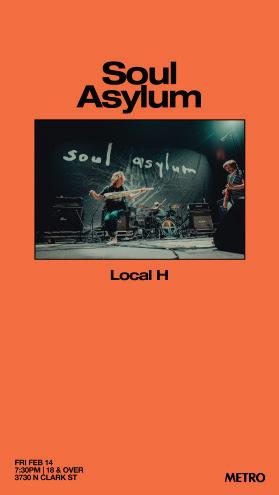 —NOAH BERLATSKY
—NOAH BERLATSKY
WEDNESDAY15
Caroline Polachek Part of the Tomorrow Never Knows festival. Born Days and Desert Liminal open. 9 PM, Lincoln Hall, 2424 N. Lincoln, $20. 18+
Caroline Polachek might be the queen of crushes. As half of the synth-pop duo Chairlift, she wrote cheeky sleeper favorites such as “Crying in Public” and “Bruises” in the late 2000s, before branching out into solo work, taking opera lessons (inspired by a Handel aria in the soundtrack of the 2009 Lars von Trier film Antichrist ), and providing guest vocals for artists such as Blood Orange, Charli XCX, and Sbtrkt. In 2014 she put out Arcadia as Ramona Lisa, and three years later she dropped Target Around the Arrow under her initials, CEP. Last year Polachek fi nally released her first album under her proper name, titled Pang .

Coproduced by PC Music’s Danny L. Harle, it lands within the sweet spot of the singer’s previous work: its eclectic blend of electronic, ambient, and pop infl uences echoes Chairli ’s art-pop and laces it with baroque flair. At times, Pang feels like an operatic saga interspersed with upbeat interludes; most of the album’s standout tracks (“Ocean of Tears,” “Door”) combine synth-heavy beats with a big infusion of pop, and treat Polachek’s soaring vocals with a vocoder. The album chronicles the lifespan of a crush—lust, love, letting go—and its name is an allusion to an arrow hitting the heart.

On the title track, Polachek breathily sings of the first sparks between potential flames—“Into me / Pang, and I go / Into you / Pang”—and the games begin. Pang beckons listeners to dance through the mental gymnastics of a new relationship, dipping into moods such as euphoric surrender (“Hit Me Where It Hurts”) and self-critical hyperfixation ( “Caroline Shut Up”) and culminating in postbreakup pining (“So Hot You’re Hurting My Feelings”).


With an arsenal of lovelorn ballads that arc from initial giddiness to imminent heartbreak, Polachek draws back her arrow and takes aim.
—MADELINE

JANUARY 9, 2020 - CHICAGO READER 31
HAPPOLD
Caroline Polachek COURTESY THE ARTIST
SMARTBARCHICAGO.COM 3730 N CLARK ST | 21+ 3730 N. CLARK ST METROCHICAGO.COM METROCHICAGO@ TICKETS AVAILABLE VIA METRO + SMARTBAR WEBSITES + METRO BOX OFFICE. NO SERVICE FEES AT BOX OFFICE! TOMORROW NEVER KNOWS 2020 WITH BLACK MARBLE HOOPS / VARSITY SAT JAN 18 MAGIC CITY HIPPIES TIM ATLAS FRI JAN 31 SOUL ASYLUM LOCAL H FRI FEB 14 FOR FRANKIE! Queen! in association with FKF presents 10:00PM 21 & Over Sunday 01/19/20 A Celebration of his 65th Birthday with MICHAEL SERAFINI GARRETT DAVID / ALAN KING MARK GRANT / ZAC JONES
LArry June Kapo Bravado, Milo 187, and 3am open. 8 PM, Subterranean, 2011 W. North, $25. 17+

Rappers have been more than game to roll with pop culture’s endless churn, and Larry June is especially skilled at releasing new material fast enough for perpetually refreshed feeds. In the past 12 months, the Bay Area MC has dropped six full-lengths on his Freeminded label: February’s Early Bird , April’s The Port of San Francisco , June’s Mr. Midnight , September’s Out the Trunk , and November’s Product of the Dope Game . Oh,
and don’t forget May’s Trap Larry, a collaborative mixtape EP with trap super-producer Lex Luger. In fact it won’t surprise me if he puts out more music between the publication of this piece and his Subterranean show. June has the kind of easygoing temperament that makes his loose lines sound equally comfortable atop Luger’s claustrophobic trap and the refined modern-funk melodies of his studio albums. June’s verses are so steeped in the specifics of his life—his regular Trader Joe’s visits, his trip to Tokyo—that his songs can feel diaristic. Maybe that’s why he makes so much music—just to help himself process the world. —LEOR GALIL v

32 CHICAGO READER - JANUARY 9, 2020 ll
continued from 31










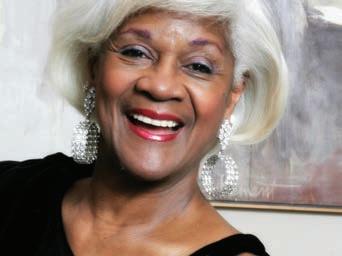










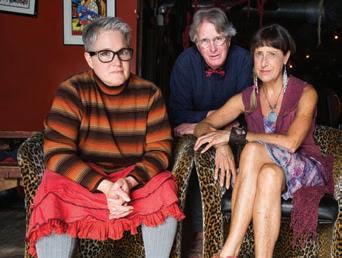

JANUARY 9, 2020 - CHICAGO READER 33 1200 W RANDOLPH ST, CHICAGO, IL 60607 | 312.733.WINELIVE MUSIC IN URBAN WINE COUNTRY feb jan House of Bodhi with Lola Wright David Broza & Friends feb 45 14 STORM LARGE OF PINK MARTINI jan jan jan jan jan jan jan jan feb feb jan jan jan feb MELI’SA MORGAN SIMPLY THE BEST TINA TURNER TRIBUTE SY SMITH INDIE SOUL JOURNEYS SCREENING & PERFORMANCE MIDGE URE SONGS, QUESTIONS & ANSWERS Elle Varner WITH J. BROWN Robert Randolph & the Family Band Sons of the Never Wrong with Katie Dahl SAWYER FREDERICKS WITH BETH BOMBARA jan Mac Powell & the Family Reunion Third Day Frontman The Men of Mister Kelly’s AN ACOUSTIC EVENING WITH YUNA 15 19 20 21 25 26 27 28 29 1 2 12 13 23 + 24 6 Josephine Beavers Great American Songbook Eric Benét Pat McGee Band jan 17 + 18 MIKI HOWARD FEAT. GLENN JONES jan 16 GLEN PHILLIPS OF TOAD THE WET SPROCKET CHRIS BARRON OF SPIN DOCTORS FRIEDA LEE 80TH BIRTHDAY CELEBRATION
Leor Galil GLITTER GUTS


NEW YEAR’S RESOLUTION
By LEOR GALIL

I’ve spent most of the new year saddled with a bad cold, and just as I thought I was coming out of it I got hit by an unexpected fever. Perhaps this is my punishment for seeing the film adaptation of the musical Cats on New Year’s Day, or for not seeing Cats as soon as it landed in theaters, or for my deep desire to find a way to reference Cats in everything I do (here I go again). Fortunately, my illness hasn’t prevented me from kicking o my New Year’s resolution: to visit every Chicago Public Library branch.
I love the Harold Washington Library dearly, I’ll sometimes make excuses to do research there just to find a way to swing through if I haven’t been there recently (note to all punks: HWL has every issue of the legendary zine Maximum Rocknroll available to read on the eighth floor). And I try to stop in the CPL location closest to me at least once a week, which is part of what’s sparked my interest in visiting all the other branches. I’m so curious about how these various libraries fit in with their respective communities, and this felt like a fun way to get a greater understanding of what makes each neighborhood unique. On Saturday, I took the first step in this yearlong adventure and
stopped by the Bucktown-Wicker Park Library to peruse its Chicago book collection.
I’m already dreaming of visits to branches I’ve never seen. I just hope when I stop in at the Richard M. Daley branch in Humboldt Park I’ll be able to surprise rapbrarian Roy Kinsey at his day job.

What I’m reading



Rap on Trial, by Erik Nielson and Andrea L. Dennis

-“The Fool’s Journey: 2010-2019,” by Jes Skolnik (The Parts of a Body)
Blue: The Color of Noise, by Steve Aoki (It’s not well written, but if you’ve ever been curious about Aoki’s evolution from straightedge hardcore lifer to EDM icon, this book has you covered.)


What’s on my playlist



-Eggboy, Eggboy 98-05

-Sasquatch, Star Crossed EP
-Kiwi Jr., Football Money
-Rxckstxr, “Puppy Dog Bouncin (in the Box)” v
@imLeor
34 CHICAGO READER - JANUARY 9, 2020 ll MUSIC
Checking out every CPL branch
Less scrolling. More strumming. Anyone can play! Find your summer class at oldtownschool.org Give your digital life a break. Connect over music, dance & more.
EARLY WARNINGS
Reggies’ Music Joint Terry Reid & Railheart 4/25, 8 PM, SPACE, Evanston b Releaser, Burst & Bloom 1/25, 7:30 PM, Beat Kitchen, 17+
WOLF
NONAME’S BOOK CLUB has become a national phenomenon since it launched in July. Each month the Chicago rapper selects two books by authors of color and encourages readers to pick them up from indie booksellers or local libraries. Since August, the club has helped organize monthly meet-ups across the country (five in November, including the first in Chicago), and Noname launched a Patreon in December to help send the club’s selections to prisons in various cities. Noname’s Book Club has also declared Saturday, January 11, the first National Fuck Amazon Day, encouraging readers to cut ties with the biggest bookstore in the world—and the one that evades the most in taxes!—by applying for library cards.
Since Led Zeppelin 2 came hopping down from the Misty Mountains in 2008, Gossip Wolf has often marveled at this Chicago cover band—especially their ability to stay out of copyright-related legal trouble! Joking aside, vocalist Bruce Lamont (Yakuza, Bloodiest), drummer Greg Fundis , bassist Matthew Longbons , and guitarist Paul Kamp (Busker Soundcheck) sell out venues from here to Mordor by playing with disarming historical accuracy, punishing rhythmic power, and (natch) a whole lotta love. At House of Blues on Friday and Saturday, January 10 and 11, they kick off a six-week tour celebrating the 50th anniversary of Led Zeppelin III
Local guitarist and composer Kevin and Hell makes idiosyncratic music that mashes up small-combo jazz and zonked-out postpunk—like Wes Montgomery jamming with the Cleaners From Venus, speckled with Sun Ra’s eeriest synth tones. On Friday, January 10, he drops Sounds of an Electric Fantasy (Midwest Action), which features his strongest support cast yet, including Angel Bat Dawid on clarinet, Natalie Lande on saxophone, and Tommaso Moretti on drums. They celebrate the release with a show that night—also Kevin’s birthday!—at Bernice’s in Bridgeport.
—J.R. NELSON AND LEOR GALIL
Got a tip? Tweet @Gossip_Wolf or e-mail gossipwolf@chicagoreader.com.

NEW
Aperiodic 1/25, 7:30 PM, Gray Center for Arts and Inquiry F b
Avalon String Quartet 5/16, 7 PM, Unity Temple, Oak Park b
Barn Dance Apocalypse featuring Golden Horse Ranch Band 2/29, 8 PM, Irish American Heritage Center Baseball Furies launch party featuring Diff, Cinco De Gatos, DJ Joe Shanahan 1/26, 5 PM, GMan Tavern Lindsay Beaver 2/18, 8 PM, FitzGerald’s, Berwyn, on sale Fri 1/10, 11 AM
Behind the Scene featuring Kahrion, Noah Chris 1/23, 9 PM, Schubas, 18+ F Blockhead, Arms & Sleepers, Il:lo 1/23, 8:30 PM, Lincoln Hall, 18+
Patrizio Buanne 2/12, 8 PM, City Winery b Buk Psychodrama, Dawreck Triple Darkness, Color One, Staxx Malone, Sherm N Demand, DJ George tha Jamma 1/24, 10 PM, Subterranean
Dave Burrell 1/25, 8:30 PM, Constellation, 18+ Nick Cannon presents MTV Wild ’N Out Live featuring Saweetie 3/20, 8:30 PM, United Center, on sale Fri 1/10, 10 AM b
Mark Caro’s Talking in Space series featuring Jon Langford 1/21, 7:30 PM, SPACE, Evanston b Chachuba, Biomassive, Chalk Dinosaur 1/24, 8 PM, Beat Kitchen
Claudettes 4/3, 8:30 PM, FitzGerald’s, Berwyn, on sale Fri 1/10, 11 AM
Cowboy Bullies, Extracto 1/17, 8 PM, GMan Tavern
Savannah Cristina, Bria 1/16, 8:30 PM, Subterranean Dance With The Dead, Magic Sword, Das Mörtal 4/17, 8 PM, Bottom Lounge, on sale Fri 1/10, 10 AM, 17+ Deep Breakfast featuring Macie Stewart, Rob Frye 1/19, noon, Sleeping Village Dying in Designer, Lil Xtra 1/17, 8 PM, Beat Kitchen, 17+ Embracing the Spirit: the Legacy of Dr. Martin Luther King Jr. presented by 6Degrees Composers and featuring Keith Hampton Singers, Gail James, Teniya Farnandis, Christopher Joyner, Janice Misurell-Mitchell, and more 1/20, 7 PM, Grace Place Episcopal Church F b Expendables, Bumpin Uglies, Artikal Sound System 4/3, 7 PM, Bottom Lounge, 17+ J Fernandez, Peel Dream Magazine, Claude 2/5, 9:30 PM, Sleeping Village Flesh Panthers, Uncle Sexy & the Nephews, Magic Ian 1/31, 9 PM, Empty Bottle Foons 1/31, 9 PM, Schubas, 18+ Fundamental Kink, Gazebo Effect, Capital Soirée 2/12, 9:30 PM, Sleeping Village Girl K, Sports Boyfriend, Floatie 2/16, 9 PM, Sleeping Village Graduating Life, King of Heck 3/28, 7 PM, Cobra Lounge b Gordon Grdina’s Nomad Trio 1/16, 9 PM, Elastic b John Papa Gros 3/26, 8 PM, SPACE, Evanston b Hausu Mountain showcase featuring Fire-Toolz, RXM Reality, Quicksails, Pepper Mill Rondo 1/28, 8:30 PM, Empty Bottle
Hieroglyphic Being, Angel Bat Dawid 1/21, 8:30 PM, Empty Bottle
Ides of March featuring Jim Peterik 3/4, 8 PM, City Winery b
Illogical, Comfort Scarcity 1/17, 7 PM, Bottom Lounge, 17+ Indie Soul Journeys screening with Sy Smith 1/28, 8 PM, City Winery b Matt Jencik, Forest Management 1/29, 8:30 PM, Empty Bottle
Josh Kelley 4/29, 8 PM, City Winery b Kesha, Big Freedia 5/23, 7:30 PM, Huntington Bank Pavilion, on sale Fri 1/10, 10 AM b
Kneebody 1/23, 8:30 PM, Constellation, 18+ Knees, Bascinets, Moontype 2/21, 9:30 PM, Hideout Lambert 3/25, 8 PM, SPACE, Evanston, on sale Fri 1/10, 10 AM b
Little Lizard, Eric Dontè, Henry Hank, Kevin and Hell 2/26, 8:30 PM, Empty Bottle Liz Longley 5/12, 8 PM, SPACE, Evanston, on sale Fri 1/10, 10 AM b
Maeve & Quinn 3/4, 8 PM, SPACE, Evanston, on sale Fri 1/10, 10 AM b Man Or Astro-Man?, Wray 2/26, 9 PM, Sleeping Village Minks 4/28, 8:30 PM, Empty Bottle
Music Frozen Dancing 2020 featuring Hot Snakes, Pissed Jeans, Hide, Mauskovic Dance Band, Hecks, Hitter 2/22, 1 PM, Empty Bottle F b
Paloma Mami 3/9, 7:30 PM, Schubas b Petrol Girls, Typesetter 3/23, 9:30 PM, Sleeping Village Pledge Drive, Material Girls, Lipschitz 1/26, 9:30 PM, Sleeping Village
Queen! presents Honey Soundsystem, Michael Serafini, Garrett David 2/28, 10 PM, Smart Bar Queers, Dollyrots, Handguns, Capgun Heroes 3/20, 7 PM,
Rempis/Lopez/Packard trio with Jen Hill 1/28, 9 PM, Elastic b
Rempis/Lopez/Packard trio with Sam Pluta 1/21, 9 PM, Elastic b
Jason Roebke (solo set), Clinkman/Heinemann/Sudderberg 1/23, 9 PM, Elastic b
Rotting Christ, Borknagar, Wol eart, Abigail Williams, Imperial Triumphant 3/28, 6 PM, Reggies’ Rock Club, 17+ Rusko 2/7, 9 PM, Concord Music Hall, 18+
DJ Seinfeld, Olin 2/14, 10 PM, Smart Bar
Simply The Best: A Tribute to Tina Turner featuring Elisa Latrice 1/26, 7 PM, City Winery b Chris Smither 7/15, 8 PM, SPACE, Evanston b Soup & Bread featuring DJ Scott Schaefer 1/22, 5:30 PM, Hideout
Southern Hospitality 6/19, 8 PM, SPACE, Evanston, on sale Fri 1/10, 10 AM b
Split Single, Eyelids 5/30, 8 PM, SPACE, Evanston b Spun Out, Cafe Racer, Finesse, DJ El Lobo Cabrón 1/23, 9 PM, Sleeping Village
Rod Stewart, Cheap Trick 9/5, 7:30 PM, Hollywood Casino Amphitheatre, Tinley Park, on sale Fri 1/10, 10 AM b
Storm Large 2/5, 8 PM, City Winery b
Svdden Death, Ray Volpe, Kleavr, Tantrum, and more 1/11, 1 AM, Concord Music Hall, 18+
Thompson Springs, Max Subar, Many Places 1/21, 9:30 PM, Sleeping Village
Lina Tullgren, Spirits Having Fun, Moon Type 1/26, 8:30 PM, Empty Bottle
Whethan, Chrome Sparks, Ramzoid 4/2, 8 PM, Riviera Theatre, 18+ Windy City Soul Club 1/25, 9 PM, Sleeping Village Wish You Were Here 3/13, 9 PM, Sleeping Village Wvrm, Ether Coven, Barishi, Deathrun 1/24, 7:30 PM, Reggies’ Music Joint Yoshi Flower 3/13, 7 PM, Cobra Lounge b
UPDATED
Heavy 2/6, 7:30 PM, Park West, canceled; contact point of purchase for refund information b
Phillip Phillips 1/30-1/31, 8 PM, City Winery, 1/30 sold out; 1/31 added b
UPCOMING
Allie X 3/31, 7:30 PM, Subterranean b
Almost, All Get Out, Ghost Atlas, Rowdy 1/19, 7 PM, Bottom Lounge, 17+ Dave Alvin & the Guilty Ones 1/25, 8:30 PM, FitzGerald’s, Berwyn
Oren Ambarchi, Crys Cole 2/24, 8:30 PM, Constellation, 18+
Steve Aoki 3/13, 9 PM, Aragon Ballroom, 18+ Bodega 2/10, 9 PM, Schubas Bodysnatcher, Great American Ghost, Born A New 2/19, 7 PM, Cobra Lounge, 17+ Cam’ron 2/25, 8 PM, Bottom Lounge, 17+
Destroyer, Eleanor Friedberger 3/1, 8 PM, Thalia Hall, 17+ Earthgang, Mick Jenkins 1/31, 10 PM, House of Blues, 17+ Hayden James (DJ set) 1/17, 10 PM, Spy Bar
Kembe X, Alex Wiley 2/9, 7 PM, Schubas b Kojey Radical 2/19, 8 PM, Schubas, 18+
La Adictiva Banda San Jose De Mesillas 2/29, 8 PM, Rosemont Theatre, Rosemont b La Roux 3/13, 7:30 PM, Park West b
Ben Lee 1/24, 8 PM, SPACE, Evanston b Yundi Li 3/9, 8 PM, Auditorium Theatre b
Lil Wayne 3/28, 9 PM, Radius Chicago, 18+ Liquid Soul 2/7, 10 PM, SPACE, Evanston b
Pro-Pain 3/29, 7:30 PM, The Forge, Joliet b Run River North, New Dialogue 2/1, 8 PM, Subterranean, 17+
Samoht, Devin Tracy 1/16, 8 PM, The Promontory Tove Lo, Alma 2/19, 7:30 PM, Riviera Theatre b
Waco Brothers 1/24, 8:30 PM, FitzGerald’s, Berwyn Wailers 2/21, 7:30 and 10 PM, SPACE, Evanston, 7:30 PM show sold out b

Wailin’ Jennys 2/1, 7 PM, Patio Theater b
Waltzer 2/7, 9:30 PM, Sleeping Village Warish 3/2, 7 PM, Subterranean, 17+
Chely Wright 3/22, 8 PM, SPACE, Evanston b Yuna 1/17, 8 PM; 1/18, 7 and 10 PM, City Winery b
JANUARY 9, 2019 - CHICAGO READER 35
Never miss a show again. Sign up for the newsletter at chicagoreader. com/early
CHICAGO SHOWS YOU SHOULD KNOW ABOUT IN THE WEEKS TO COME b ALL AGES F A
furry ear to the ground of the local music scene
GOSSIP
WOLF BY KEITH HERZIK Queers COURTESY THE ARTIST
OPINION
SAVAGE LOVE
Busting the myths of modern porn Plus, advice on whether you should delete NSFW pictures of your exes.


: I have a question about porn, and I can’t think who else I can ask that will give me an intelligent, educated answer. In modern porn, anal on women is gaining popularity. I’m a fan of anal with my boyfriend. However, in porn, it seems like the gaping asshole is a thing, a sought a er thing, a desired thing. And I guess my boyfriend and I don’t get it. We can get quite vigorous when we have anal sex, but MY butthole never gapes open like that—my boyfriend assures me that when he pulls out, it goes back to its cute little flower-like effect. Why is the gaping asshole so popular? I promise this is not a frivolous question or just for titillation. We really do wonder: What gives? —GAINING ANAL PERSPECTIVE ENTAILS SERIOUS QUESTION







a: It’s funny how a chief fear about anal sex—that your asshole would gape open a erward and poop would fall out while you walked down the street—became eroticized. (The asshole gaping open part, not the poop falling out part.) Did I say funny, GAPESQ? I meant predictable. Because a big part of the collective human subconscious is always at work eroticizing our fears, and the gaping-open, just-beenfucked, completely “wrecked” asshole many people feared inevitably became something some people found hot. And as more people began experimenting with anal sex—as anal went mainstream over the last two decades— people realized that the anal sphincter is a muscle and the secret to successful anal intercourse is learning to relax that muscle. Situationally, not
permanently. You could relax, get loose, gape a er, post the video to a porn tube, and then tighten back up. Now, not everyone thinks a wide-open, gaping asshole is desirable. And not everyone, in the immortal words of Valerie Cherish, needs (or wants) to see that.
Q: Honest question: If you, being a homosexual, don’t die from HIV, will you have to wear a diaper before the age of 42? Optional question: What does a prolapsed rectum look like? I bet you can describe it without doing an image search.


—SICKENING HOMOSEXUALS ARE MALIGNANT ERRORS

a: Honest answers: I know you meant this to be hate mail, SHAME, but I’m just thrilled someone out there thinks I’m not 42 yet. Also, I’m HIV-negative—last time I checked—but even if I were to seroconvert (go from HIVnegative to HIV-positive), a person with HIV who has access to meds can expect to live as long as a person without HIV. Also, a person with HIV who is on meds and has a zero viral load (no trace of the virus can be detected in their blood) cannot infect another person. So even if I were to contract HIV a er all these years, SHAME, I would likely live long enough to die of something else, and, once I got on meds, I couldn’t pass HIV on to anyone else. And quickly: I’m way past 42 and not in a diaper yet, thank you very much. And while some people think a prolapsed rectum looks like a rosebud, I happen to think a prolapsed rectum looks like a ball of lean hamburger. And the first one I ever saw—and, no, I didn’t need to do an image
search because it makes a real impression—was in straight porn, not gay porn.
P.S. If you can’t think about gay men without thinking about our poops and the diapers you hope we’re wearing and our meaty prolapsed rectums, SHAME, that says a lot more about you than it does about gay people.
Q: My significant other wants me to delete any NSFW pictures of my exes, but I don’t feel comfortable with that. I don’t have an emotional attachment to my exes or really look at these photos anymore, but I feel that old pictures saved on old computers aren’t doing any harm and deleting them won’t fix my partner’s insecurity.
PERSONAL IMAGES

CAUSING STRIFE

A: Accommodating a partner’s irrational insecurity is sometimes the price we pay to make an otherwise healthy and functional relationship work, PICS, as I recently told another reader. But one possible workaround—one possible accommodation—is telling your insecure partner what they want to hear even if it isn’t true. Telling a partner who is concerned about safety that you’re using condoms with others when you’re not isn’t OK, of course, just as telling a potential partner you’re single when you’re not isn’t okay. But telling a partner that you deleted photos you never look at on a passwordprotected computer they can’t look at . . . yeah, that’s a lie you don’t have to feel too awful about telling.
Q: How long a er using an oil-based lubricant do I have to wait before I can safely use latex condoms? Not right

36 CHICAGO READER - JANUARY 9, 2020 ll
REALPEOPLE REALDESIRE REALFUN. TryFREE: 773-867-1235 MoreLocalNumbers:1-800-926-6000 Ahoraespañol Livelinks.com18+
a er, presumably. Next day? Next week? Next century? I’ve been experimenting with oil-based CBD lube for hand/ toy stuff, but I’m worried about the timing relative to penetrative sex. —OILY INSIDE




A: “Oil and latex condoms do NOT mix, period,” said Melissa White, CEO of Lucky Bloke, an online condom shop, and a condom expert. “Using an oilbased lubricant with a condom can cause the condom to leak and/or break. And unlike water-based lubes, oils do not evaporate readily. While oil is absorbed over time, that absorption rate likely varies based on many factors, including age. Oiling up internally? Now we’re talking vaginal versus anal absorption rates! The bottom line: We have not found sufficient studies to issue a reliable recommendation on what an overall safe time frame might




be. So here’s the deal: Oil or condoms—choose one.” I would add only this: condoms made out of polyurethane are more expensive, but you can safely use them with oil-based lube.





Q: I’m a straight guy who loves the female body—the look, touch, and smell. I’m in my mid-30s, I’ve never had a serious relationship, and I don’t know if I’m capable of falling in love. I’m exclusively into trans women, and I’ve kept it a secret because it’s nobody’s business. If I were in love, I’d make it public, but that hasn’t happened. I can’t help but feel like this is an addiction, and I’m ashamed of it. I’m sure I’m not the first straight guy who’s into trans women who’s written to you. Where do I go from here?



—STRAIGHT AND STRUGGLING
A: While dating someone in secret isn’t impossible, SAS, it


rarely leads to long-term love. Being kept hidden because you’re trans (or you’re gay or you’re big) and the person you’re dating hasn’t gotten over their shame about being attracted to trans people (or members of their own sex or bigger people) . . . well, it sucks to be someone’s dirty secret. And a healthy trans (or gay or big) person—the kind of person you might be able to fall in love with—isn’t going to put up with that shit. So it’s a catch-22: so long as you keep the women you date a secret, none of them are going to stay in your life for long. They’ll be either so damaged you want them out of your life or not damaged enough to want you in theirs. v
Send letters to mail@ savagelove.net. Download the Savage Lovecast every Tuesday at savagelovecast. com

@fakedansavage

JANUARY 9, 2020 - CHICAGO READER 37
OPINION Visit www.squirt.org to hook up today Hookups = MoreLocalNumbers:800-777-8000 www.guyspyvoice.com Ahora enEspañol/18+ 60MINUTESFREETRIAL THEHOTTESTGAYCHATLINE 1-312-924-2082 Meetsexyfriends whoreallygetyourvibe... MoreLocalNumbers:1-800-811-1633 Try FREE:312-924-2066 vibeline.com18+
A series of political engagement events as curated by
Indivisible
January 9, 2020
12pm - 1pm 5539 N. Broadway
Drinks & Dialogue:
January 9, 2020
5:30pm - 7pm
Mariano’s Fresh Market 2112 N. Ashland Ave. 2nd Floor
Burning Bowl: Homecoming 2020
January 11, 2020
1pm - 4pm Charles A. Hayes Family Investment Center 4859 S. Wabash Ave
Handmaids Stand Against MFL
January 11, 2020
12:30pm - 3:30pm Daley Center Plaza 50 W. Washington St.
Happy Blue Year: Women’s March Sign Making Activity!
January 13
5pm
Black Ensemble Theater 4450 N. Clark St.
Happy Blue Year 2.0
January 13
6pm - 8:30pm Black Ensemble Theater 4450 N. Clark St.
Sunrise Movement - January Hub Meeting January 14
6pm - 7:30pm George C. Hall Library 4801 S. Michigan Ave.
Solidarity With Our Neighbors: Chicago Immigrants and Their Allies
January 14 7pm - 9pm KAM Isaiah Israel 1100 E. Hyde Park Blvd.
Bus Ride to Women’s March Chicago January 18
9am - 3pm Ogden Mall 1271 E. Ogden Ave. Naperville, IL
Fox Valley Illinois Women’s March January 18 12pm - 1pm Downtown Geneva 100 S. 3rd St. Geneva, IL
Women’s March Chicago 2020 January 18
11am - 1pm Grant Park
Impact of the 2020 Census: Collections, Concerns, Changes January 21
5:30pm - 7pm Union League Club of Chicago 65 W. Jackson Blvd.
Roe Vs. Wade Anniversary Event January 23 5:30pm - 9pm Morgan Manufacturing 401 N. Morgan St. Candidate Forum: US House of Representatives IL1 January 23
7:30pm - 9pm First Unitarian Church of Chicago 5650 S. Woodlawn Ave.
How to be an Antiracist
January 28 6pm - 7:30pm League of Women Voters 332 S. Michigan Ave.
Public Workshop February 9 4pm - 6pm Chicago Therapy Collective
CLASSIFIEDS
JOBS GENERAL
(Schaumburg, IL) Misumi USA, Inc. seeks Corporate Planning Analyst w/ Bach or for deg equiv in fin, acct, law or rltd field & 2 yrs exp in job offered or perform corp & tax acct for US subsid of Japanese comp using GAAP, incl 1 yr exp implem J-SOX; Toyota Prod Syst; corp budget & bus plan; & determ strengths & weak of bus oper. Apply to: B. Arbetman, 1717 Penny Lane , Schaumburg, IL 60173

Senior Institute Scientist-Gasification Technology – Scientific/ engineering leadership of gasification tech and biz development in the R&D org. Duties: guide attack on gasification probs; attract work and lead professionals in gasification efforts; support relations w customers and govt reps, establish new relations w customers, and devel opportunities to expand tech offerings globally; lead scientific/ engineering programs to accomplish org objectives; lead biz capture teams and perform market assessments; resp for contractual success, accomplishment of objectives, and compliance with requirements for all projects. Reqd: BS in Chem, Chem Eng, or Petroleum Eng; Ph.D. in Eng; 15 yrs exp in gasification, incl tech/R&D work in chem/petroleum eng and operation of int’l programs/projects; perm US work auth. Dir inquires to Institute of Gas Technology, 1700 S. Mount Prospect Rd., Des Plaines, IL 60018, Attn: J. Otahal, HR.
REAL ESTATE RENTALS
APARTMENT TO SHARE
Albany Park Apartment to Share If you are a dog walker, work in the pet industry, or a college student this could be for you, however, all applications are taken. Furnished apartment, great rent at $525. Help take care of dogs. Bedroom available. Free laundry and many perks. Danny. 773-618-0004
1 BEDROOM Large one bedroom for sublease from 1/1 through 5/31/20. 6828 N. Wayne. Hardwood floors. Pets OK. Heat included. Laundry in building. $935/month. (773) 7614318. www.lakefrontmgt. com.
2 BEDROOM UPTOWN, LARGE 2 BDRM, Rehabbed Vintage. Formal Dining Room, Hardwood floors, 4346 N Clarendon Ave (At Montrose). Two Blocks from lake. Heat Included. Please call 773-935-4425. $1475
MARKETPLACE
GENERAL LEGAL NOTICES
This letter is to notify that on January 25, 2020 at 9:00 a.m. an auction will be held at 83rd & Halsted Self Storage, Inc., located at 8316 S. Birkhoff Ave, Chicago, IL 60620, to sell the following articles held within said storage units to enforce a lien existing under the laws of the state of Illinois.
1. 199 Jade McCray
2. 459 Michelle Camphor
3. 329 Stanley Matthews
4. 125 Stanley Matthews
5. 140 Kristen Blackman
6. 320 Stanley Matthews
7. 250 Carl Childress
8. 210 Gerald Warren
9. 246 Oprah Lindsey
10. 206 Katrina Lee
11. 498 Willie Smith
This letter is to notify that on January 25, 2020 at 9:00 a.m. an auction will be held at Hyde Park Self Storage, Inc., located at 5155 S. Cottage Grove Ave, Chicago, IL 60615, to sell the following articles held within said storage units to enforce a lien existing under the laws of the state of Illinois.
1. 566 Daniel Goldman
2. 493 Edward Schmeltzer
3. 227 Robert W. Sales
4. 202A William Brown
5. 10176 Devra R. Saunders
6. 490 Dorothy H. Ragsdale
7. 10177 Kenneth Williams
8. 52 Elaine T. Louis
9. 39 Theresa Thapedi
This letter is to notify that on January 25, 2020 at 9:00 a.m. an auction will be held at South Shore Self Storage, Inc., located at 7843 S. Exchange Ave, Chicago, IL 60649, to sell the following articles held within said storage units to enforce a lien existing under the laws of the state of Illinois.
1. 320 Balencia Petty
2.238 Lafeyette Campbel
3. N008 Nicole Watson
4. 606 Diane Taylor
5. 461 Larissa Johnson
6. 302 Jamel Amos
7.370 Chevelbia Williams
8. 313 Donna Boyd
9. 568 William G. Robinson
10. 374 Preston Phillips
11. 602 Gregory Thomas
12. N010 William Slater
13. 605 Susan Clay
This letter is to notify that on January 25, 2020 at 9:00 a.m. an auction will be held at Aaron Bros. SelfStorage, Inc., located at 4034 S. Michigan Ave, Chicago, IL 60653, to sell the following articles held within said storage units to enforce a lien existing under the laws of the state of Illinois.
1. 345 Kermit Waddy
2. 121 Candee Henley
3. 566 Cassius Rudolph
4. 304 Dianna Murray
5. 229 Ishmael McDaniels
6. 436 Charisma Ward
7. 2000 Nina Powell
8. 335 Diannah Minefee
9. 247 David Powell
10. 500 Michael Griffith
11. 228 Bethany Pickens
12. 552 Michael Weston
PUBLIC NOTICE OF INTENT TO DISSOLVE Notice is hereby given that Triggr Health, Inc, 111 W. Illinois, Chicago, IL 60654, has ceased doing business and has filed with the Delaware Secretary of State a Certificate of Dissolution in connection with its liquidation and dissolution. Any claim against this Company should be in writing and mailed to the above address and should detail the name and address of the claimant and the substance of the stated claim. Any claim against this Company will be barred unless a proceeding to enforce the claim is commenced within sixty (60) days after publication
WANT TO ADD A LISTING TO OUR CLASSIFIEDS? E-mail tallen@chicagoreader.com with details or call (312) 392-2970



38 CHICAGO READER - JANUARY 9, 2019 ll
JOBS ADMINISTRATIVE SALES & MARKETING FOOD & DRINK SPAS & SALONS BIKE JOBS GENERAL REAL ESTATE RENTALS FOR SALE NON-RESIDENTIAL ROOMATES MARKETPLACE GOODS SERVICES HEALTH & WELLNESS INSTRUCTION MUSIC & ARTS NOTICES MESSAGES LEGAL NOTICES ADULT SERVICES
IL9 Weekly Roundtable
Diversity & Inclusion
For more information of listed events please visit persistlist.org MOBILIZE sponsored byMOBILIZE
of this notice. The Company maintains the authority and right to make distributions to other claimants, the Company’s stockholders, or other persons.

Notice is hereby given, pursuant to “An Act in relation to the use of an Assumed Business Name in the conduct or transaction of Business in the State,” as amended, that a certification was registered by the undersigned with the County Clerk of Cook County. Registration Number: Y19002831 on December 18, 2019.
Under the Assumed Business Name of JAK SPEECH AND LANGUAGE SERVICES with the business located

at: 21 E. HURON, #2002, CHICAGO, IL 60611. The true and real full name(s) and residence address of the owner(s)/partner(s) is: JAMIE A. KURZMAN 21 E. HURON, #2002 CHICAGO, IL 60611, USA.
Notice is hereby given, pursuant to “An Act in relation to the use of an Assumed Business Name in the conduct or transaction of Business in the State,” as amended, that a certification was registered by the undersigned with the County Clerk of Cook County. Registration Number: Y19002862 on December 26, 2019.
Under the Assumed Business Name of FIT COPYWRITING with the business located at 1100 North Dearborn Street
Apt 615, Chicago, IL 60610. The true name and address of the owner is Daniel Lona, 1100 North Dearborn Street Apt 615, Chicago, IL 60610 /s/ Karen A. Yarbrough Cook County Clerk.
ADULT SERVICES
Danielle’s Lip Service, Erotic Phone Chat. 24/7. Must be 21+. Credit/ Debit Cards Accepted. All Fetishes and Fantasies Are Welcomed. Personal, Private and Discrete. 773-935-4995
pleaserecycle thispaper
JANUARY 9, 2019 - CHICAGO READER 39


 By MATT HARVEY
By MATT HARVEY

















 By MICCO CAPORALE
By MICCO CAPORALE

 By BEN JORAVSKY
By BEN JORAVSKY

























 By SRUTHI DARBHAMULLA
By SRUTHI DARBHAMULLA

 LAURA MOLZAHN
LAURA MOLZAHN











 By KERRY REID
By KERRY REID

























 By MATT HARVEY
By MATT HARVEY









 —CATALINA MARIA JOHNSON
—CATALINA MARIA JOHNSON






 —NOAH BERLATSKY
—NOAH BERLATSKY



















































































